
* A Distributed Proofreaders Canada eBook *
This eBook is made available at no cost and with very few restrictions. These restrictions apply only if (1) you make a change in the eBook (other than alteration for different display devices), or (2) you are making commercial use of the eBook. If either of these conditions applies, please contact a https://www.fadedpage.com administrator before proceeding. Thousands more FREE eBooks are available at https://www.fadedpage.com.
This work is in the Canadian public domain, but may be under copyright in some countries. If you live outside Canada, check your country's copyright laws. IF THE BOOK IS UNDER COPYRIGHT IN YOUR COUNTRY, DO NOT DOWNLOAD OR REDISTRIBUTE THIS FILE.
Title: Round the Year with Enid Blyton—Winter Book
Date of first publication: 1934
Author: Enid Blyton (1897-1968)
Date first posted: May 30, 2019
Date last updated: May 30, 2019
Faded Page eBook #20190561
This eBook was produced by: Alex White & the online Distributed Proofreaders Canada team at https://www.pgdpcanada.net

WINTER TIME

A SPIDER’S WEB SPANGLED WITH FROST CRYSTALS

ROUND THE YEAR
WITH
ENID BLYTON
WINTER TIME
EVANS BROTHERS LIMITED, LONDON
ENID BLYTON’S NATURE BOOKS
ROUND THE YEAR
WITH ENID BLYTON
A YEAR’S NATURE STUDY
IN FOUR BOOKS
Spring
Summer
Autumn
Winter
In addition to the seasonal books,
there is a library edition, containing
the four books under one cover,
bound in cloth boards
LONDON
EVANS BROTHERS LIMITED
MONTAGUE HOUSE, RUSSELL SQ., W.C.1
Green Hedges,
Penn Road,
Beaconsfield
Bucks.
Dear Boys and Girls,
I wish you could come with me and walk over the hills, through the fields, and down by the river, finding a hundred exciting or beautiful things by the way. I should like to take you fishing in the ponds, and fill your jars with snails and tadpoles. I should like to help you to make a fine bird-table, or to prepare a splendid aquarium. I should like to give you a garden of your own, and show you how to make it a place of bright colours and sweet scents.
But I cannot do all these things—so instead I have written these four books for you, so that you may read them and do for yourselves all the things I would like to do with you. We will go round the year together, and you must discover with your teacher and your friends all the exciting things there are to be found in Nature study.
Good luck to you in all your Nature work, and may you find as much delight in using these books as I found when writing them for you!

| CHAP. | PAGE | |
| 1. | How Things Make Ready for the Winter | 7 |
| 2. | The Story of Frost and Snow | 19 |
| 3. | The Creeping Snail | 28 |
| 4. | Making Friends with the Birds | 35 |
| 5. | The Compass | 44 |
| 6. | Our Evergreens | 52 |
| 7. | The Robin and the Wren | 61 |
| 8. | Foot-Writing in the Snow | 70 |
| 9. | Twigs and Their Story | 80 |
| 10. | The Friendly Tits | 89 |
Shall we go hunting in the countryside this winter to see what we can find? So many animals and insects have disappeared, and it would be fun to see if we can find a few of them. What has happened to them all? Where are the wasps, the butterflies, the frogs and toads, hedgehogs and snakes? Where are the bats we saw every evening in the summer, and what has happened to the lively squirrel?
The winter is cold and food is scarce. Animals and insects must make up their minds to do one of three things if they are to live safely through the winter. They can travel far away to countries that are warm and plenteous—and this many of the birds do, as you know. Or they can curl themselves up in some sheltered spot and sleep through the winter frosts—or they can remain awake and face the hardships of the cold days, trying by means of thicker coats to fight the frosts and bitter winds. Many hungry days will be theirs and many shivering nights until the sun shines warmly again and spring comes over the green meadows.
Suppose that you were as small as a hedgehog or toad and did not mean to keep awake during the winter, what would you do? One morning there would be a nip in the air, a nip so sharp that it seemed to shrivel you up. You would crawl about looking for food, and it would be hard to find; but you would not be very hungry, because you would certainly have had a fine feast in the summer and become fat and flourishing. As the day wore on and no sun appeared you would fear the night and its sharp frost. Then an idea would creep into your mind—“I must find a good hiding-place where I can sleep safely.”
Where would you go? Think of all the places you could hide in with safety. You could creep under big stones, or cuddle into a hole in a bank. If you were sensible you would line your hiding-place with something warm, such as dead leaves or moss. Where else could you hide? Yes, in a field drain-pipe or in a hollow tree; what about in the wood-pile or in the middle of last summer’s rubbish-heap? An old nest would be a good place, wouldn’t it? A corner of a dark barn would be excellent, or underneath the roots of a tree. Both places would be dry. Then there is the thick ivy growing up the wall. It keeps its leaves all the winter and would make a fine shelter.
There are many places to choose from, and you would go on a journey of discovery, trying first this place and then that, and at last you would curl yourself up in the one most suitable to you and there fall fast asleep. You would hibernate all the winter—that is the name we give to the long sleep of animals and insects—and when you woke up in the spring-time you would feel rather thin and weak, but the sunshine and food you would find would soon put you right.
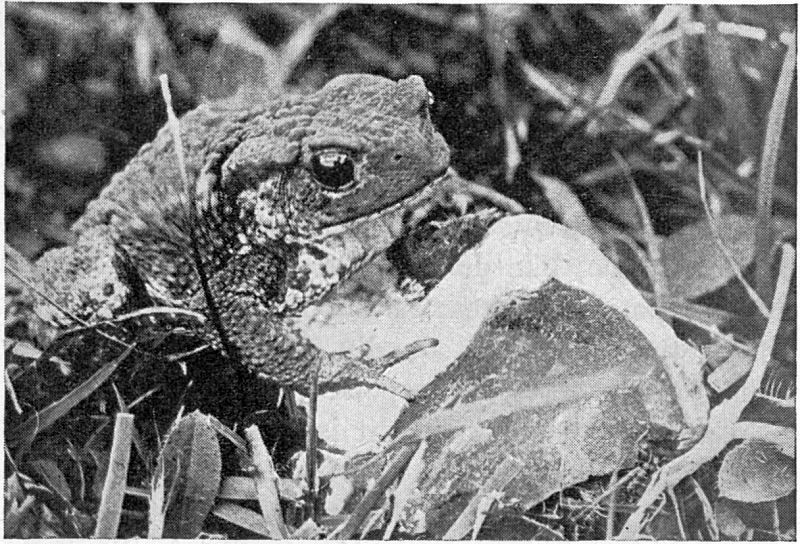
A TOAD HIDING IN A DITCH
All the places we thought were good for hiding in are chosen by some creature or other. The toads like a damp spot and prefer to creep under a stone or squat at the bottom of a moist ditch. Their cousins the frogs can often be found in wet ditches, too, but sometimes they prefer the bottom of a pond. Both toads and frogs are cold-blooded creatures—that is, their body temperature is the same as the outside air—so that you can imagine when a very frosty day comes frogs and toads are so extremely cold that they can hardly move about, and have no wish to do so. All they want is to stay still in some sheltered place.
Newts, too, like damp holes in ditches or at the sides of ponds or streams, and they curl themselves up together and sleep soundly. Young newts prefer sometimes to stay in the pond with the fish. They keep at the bottom, where it is warmer, but even if they are venturesome and swim to the top, where they become frozen into the ice, it doesn’t matter—they will thaw out in the spring-time perfectly strong and vigorous! Goldfish in out-of-door ponds often get frozen at the surface, but take no harm.
The badger, who has left his old name, Brock, in many a village name, such as Brockenhurst and Brockley, likes to be comfortable in the winter. He digs out a good deep room in the hillside or wood, and then brings in hundreds of dead leaves to make his cave warm. He blocks up the passages leading to his hiding-place so that the cold may not creep in (and also so that enemies may be kept out!) and then, when the cold days come, he takes all his family into the hiding-place, where they settle down together for a long sleep. If a warm spell comes, the badger unblocks a passage and puts his nose out to see if there is any chance of picking up some food. He is, as you see, not such a heavy sleeper as the toads or frogs, who rarely wake up during their hibernation.
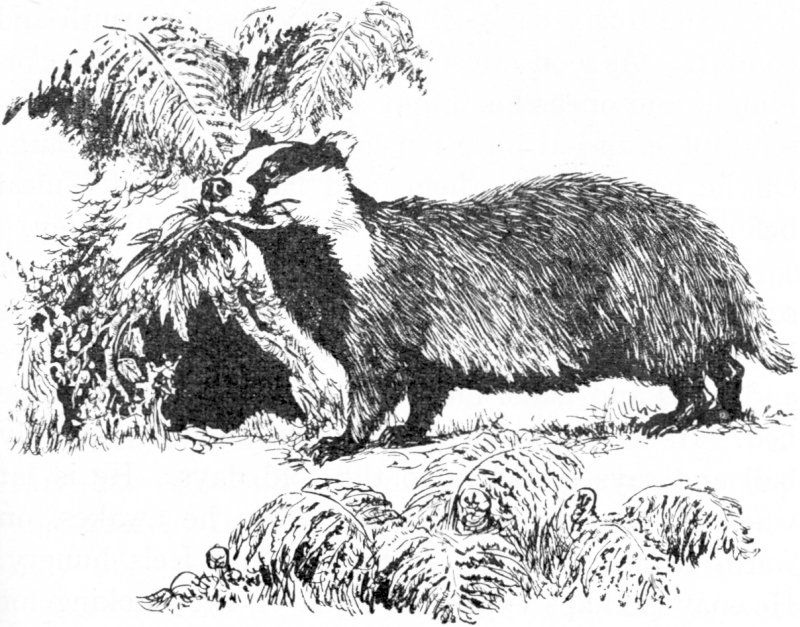
A BADGER BRINGING IN DEAD LEAVES TO MAKE HIS CAVE WARM
The squirrel, too, is not a heavy sleeper. He likes to make careful preparations for a cold winter, but he does not mean to sleep all through it if he can help it. No, he intends to wake up and have a nibble at something. You all know what he does, don’t you, when the nuts are ripening? He plucks them from the twigs and then hunts about for a good hiding-place for them. Sometimes he pops them into a hole in a tree, sometimes he hides them in the ground. He probably forgets a good many of the places, and mice discover some of them and feast in delight—but there are enough left for him, should he need them.
He takes a rook’s old nest, or a magpie’s, and builds it up for himself. Sometimes he builds quite a new nest out of twigs, moss, leaves and bark, a big affair called a “drey.” Here he curls himself up when the frosty days come, and sleeps in warmth and comfort. As soon as a sunshiny spell comes he stretches himself and opens his bright eyes. Out of the nest he scrambles, and at once remembers his hoards of nuts. Off he goes to find them, and has a splendid meal before the cold night drives him back to his drey.
The hedgehog, too, is a light sleeper, though not so light as the squirrel. He likes a nice dry hole in a bank and he is sensible enough to find dead leaves and moss and make himself a warm and comfortable bed. He cuddles down, rolls himself into a prickly ball and says good-bye to the cold days. He is fat when he begins his sleep, but when he awakes, on warm winter days, he is thinner and feels hungry. He may perhaps explore a ditch or two, looking for a hidden beetle or chrysalis before he sleeps again.
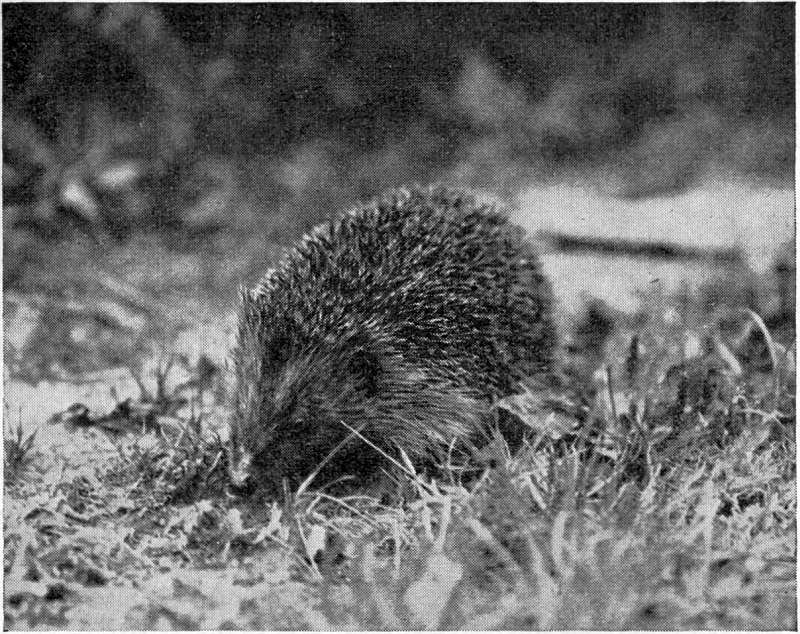
A HEDGEHOG LOOKING FOR A COSY SPOT FOR THE WINTER
The little dormouse fattens itself up well before hiding away for the winter deep underground, and it also stores up hazel nuts for a feast when it wakes, as it occasionally does. It sleeps very deeply, becomes exceedingly cold, and hardly seems to breathe. The tiny harvest-mouse spends the winter in a burrow, and near by it stores a little pile of grain so that it may not go hungry should it wake. Sometimes it passes the cold days in a hay-rick, where it is so warm that it does not sleep, but can be seen wide awake.
Caves and barns are favourite places for winter shelters. Do you know of any near your home? Go and look there, taking with you a torch or a bicycle lamp. You will find many creatures! Look up into the corners. What are those queer-shaped things hanging upside down by their feet? Yes, they are bats, all fast asleep! When they begin their winter sleep they are fat, but they get thin as the winter passes, for their bodies draw upon the stored fat and use it up. If a warm day comes, the bats wake up and fly about the barn, looking for insects.
Are there any insects in the barn or in the cave? What are those in the dark corner up there? Flash your lamp and let us see. Can you tell what they are? Butterflies, hibernating together! They are brimstones, tortoise-shells and peacocks. When the spring days come again we shall see them sailing happily in the air, their wings a little ragged, perhaps, but their colours still lovely.
Other creatures are here, too—a multitude of spiders and hosts of chrysalids, besides many smaller sleepers, all of which may become a bat’s dinner. In every nook and cranny they hide, as still as if they were dead. The spider crouches in her web and waits for spring to bring back her victims once more.
Where do the queen-wasps go? Did any of you find them this autumn, hiding stealthily in the folds of your window-curtains? Some hide in the house, and some you will find huddling under the ivy outside. The bees keep to their hives, and often busy themselves in stopping up any hole or crack through which a draught comes. As you know, they store up honey for the winter, but this we take away from them. Instead we give them something sweet to eat, and this they feast on until the first spring flowers open and offer them honey.
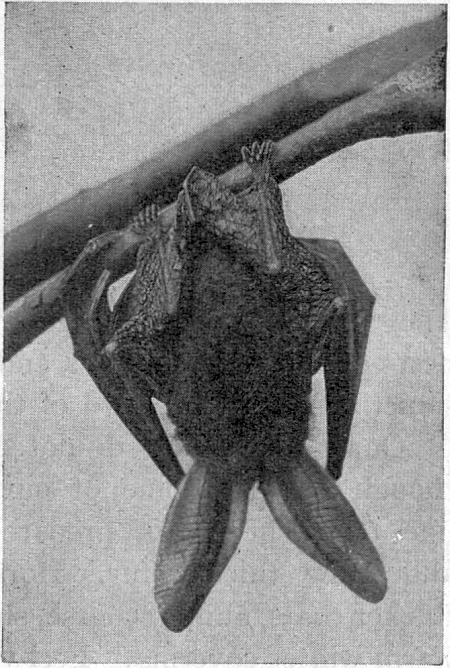
THE BAT HANGS HIMSELF UPSIDE DOWN, AND SLEEPS THROUGH THE WINTER
The velvety humble-bee tucks itself away in a hole in the ground and sleeps soundly. Caterpillars usually change into chrysalis form before the winter, though there are some that retire into a hole in the ground and others that remain in burrows they have made in the trunks of trees. Ladybirds and wood-lice (those strange creatures that roll themselves into little grey-black bullets) find cracks and crevices anywhere, and move never a leg whilst the very cold weather lasts.
Where do the snails go? I expect you have found some in your rockeries, or under crazy paving, or tucked into the cracks of walls. Pick one up and look at the underneath of it. Do you see the curious hard plate that seals up the entrance to the shell? That is what the snail has made to keep out the cold.
Have we forgotten any creature? What about snakes? Are they about in the winter-time? No—they are lovers of the sun, and cannot bear the cold. They curl themselves up in hollow trees, in the old nests of birds, in burrows and in piles of brushwood, sometimes quite a crowd of them together.
Our cats and dogs do not sleep the winter through, though perhaps some of our fire-loving cats would like to! They, too, prepare for the cold weather, and grow thicker fur. Horses and donkeys grow thicker coats, and, of course, sheep grow a marvellously warm winter covering. Feel your dog’s coat now, and then feel it again in the summer. You will find a considerable difference.
Who has a tortoise for a pet? What happens to it in the cold days? It makes a hole in the ground and buries itself! In the spring-time it heaves itself up again, and there it is, quite lively, wandering round the garden in search of nice, juicy young leaves.
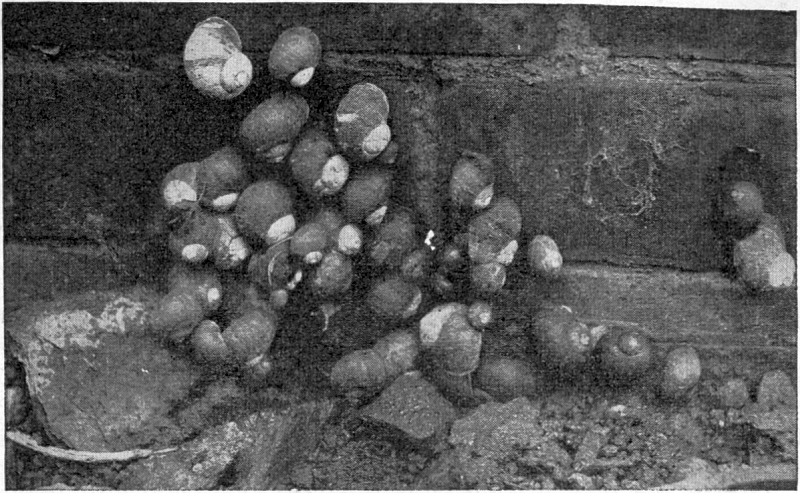
SNAILS HIBERNATING AT THE FOOT OF AN OLD WALL
Rabbits and foxes grow thicker fur, and the weasels and stoats not only grow warmer coats but, in the north, grow a differently-coloured one of snow-white, to match their wintry surroundings. In the south they do not change the colour of their coats. Farther north they grow a mixed coat of brown and white, and farther away still their entire coat is white save for the tip of their tail, which is black.
This winter you will be able to look for the hiding-places of some of the creatures I have told you about. If you find some of them, as you certainly will, don’t disturb them. Leave them to sleep in peace, and when a warm day comes, go and look at the hiding-place again, to see if its inhabitant is stirring. Look about everywhere, in hollow trees, in ditches, in the ivy or laurel, in barns and out-houses, under stones and in the cracks of your fence or wall. You are sure to find something worth talking about.
THINGS TO DO
Pretend that you are a dormouse, and describe some of the places which might do for a winter retreat for you.
Write down (a) how your cat or dog gets ready for the winter, (b) what the squirrel does, and (c) what the bat does.
When you get home go hunting in your garden or yard and see how many hidden-away insects you can find. Make a list of them, and draw one of them, or more if you can.
When you are out walking, look for an ivy-covered wall and hunt in it to see what you can find. Turn up any big stone and see if you can find a snail to take back to school, so that the others may see its sealed-up shell, if it has already prepared itself for winter.
Have you had any snow in your town or village yet this winter? If you live in the North of Britain possibly the snow is lying outside now! In the South we sometimes have no snow at all until the winter is far advanced—and even then it may not lie very long. Do you like watching a snow-storm? It is a strange feeling to stand at the window and look upwards when the snow is falling—there are such thousands of white snowflakes for ever appearing out of the leaden sky, falling steadily, silently downwards.
Why do we get frost and snow? Isn’t it a curious thing to find all the puddles turned to ice one morning, or to see the world covered in white? What makes the frost come on the window-pane, the rime cover the trees, the snow fall thick from the sky?
I expect you have a Fahrenheit thermometer in your classroom. Pass it round carefully and look at it. Look at the number 32 on it. What is printed just by it? Yes, the word Freezing. The mercury in the glass tube is far higher than that, of course, because your room is warm; but if you put your thermometer outside one cold night the silver mercury would gradually fall in the tube, and perhaps it would show freezing-point—it would sink right down to number 32. And then a strange thing would begin to happen to all the water and to all the moisture around. It would freeze.
What do we mean when we say that water freezes? In some way that is stranger than magic, and more powerful than machinery, each drop of water finds itself turned into ice. At freezing-point all the puddles in the road freeze, all the ponds are covered with ice, dripping water becomes solid and hangs from roofs in the form of icicles.
You cannot pick water up and hold it in your fingers—but you can hold it when it is solid ice. It breaks very easily when you drop it, for it is brittle.
Do you know if water takes up more room when it is liquid or when it is solid? Would a cupful of water turn into exactly the same amount of ice, or would there be less in the cup—or more? Who knows?
It is a curious thing that water, when frozen into ice, gets bigger, and takes up more room than before! Would you like to prove this for yourselves? It is quite easy. Get a lemonade or medicine bottle and fill it quite full with water. Cork it tightly and put it outside on a frosty night. In the morning your bottle will be broken!
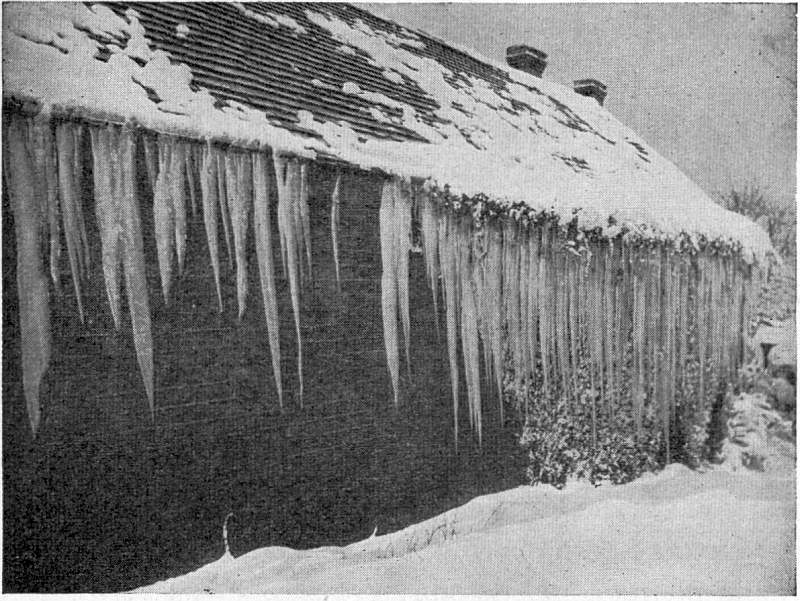
ICICLES HANGING FROM A ROOF. THE SNOW ON THE BARN MELTED, AND AS THE WATER DRIPPED OFF, IT FROZE INTO ICICLES BECAUSE THE TEMPERATURE WAS FALLING AGAIN
The frost broke it. The water in your bottle froze hard, and grew bigger as it turned into ice. It wanted more room—but there wasn’t any more room in the bottle! So it burst the glass, and thus your bottle was broken. What strength the frost had!
I am sure you have sometimes had pipes burst in frosty weather. What makes them burst? A great many people will say, “Oh, the thaw burst the pipes!” But they are wrong, aren’t they? It is the frost that bursts the pipes. The water in the pipes freezes hard and wants more room to expand as it freezes. It cannot find any more space, so it bursts our pipes—but we do not know then that they are burst, because the water inside is changed to ice, which cannot flow out of the holes made by the bursting—and only when the thaw comes and the ice changes back to water and trickles out of the holes do we see that our pipes need mending! The thaw shows us the bursts in our pipes, but it is the frost that does the damage!
The farmer welcomes the frost in winter-time, for it works better than a score of farm-labourers for him. Did you see the great clods in the fields in the autumn? If you did, perhaps you wondered how in the world young plants could possibly grow.
The frost breaks up the clods for the farmer. It freezes the moisture inside them, and when the frozen moisture tries to expand and find more room it breaks up the clods! The next time you walk by that field and tread on a clod you will find that it crumbles away to powdery earth—just right for tiny seeds to grow in when spring-time comes.
Have you seen the beautiful scrolls and ferns that the frost designs on your window-pane at night? Perhaps this very morning you got up and went to look out of the window—and you couldn’t see out because it was all “frosted over”! The frost had come in the night and put pictures on the window. How did it do it? Well, as we slept we breathed out warm breath, and some of it went to the window-pane in the form of water-vapour. The window-pane was cold and the frost lurked just outside. As soon as our breath touched the glass it froze, and as it froze there came the lovely patterns made of ice-crystals that you saw when you woke up this morning.
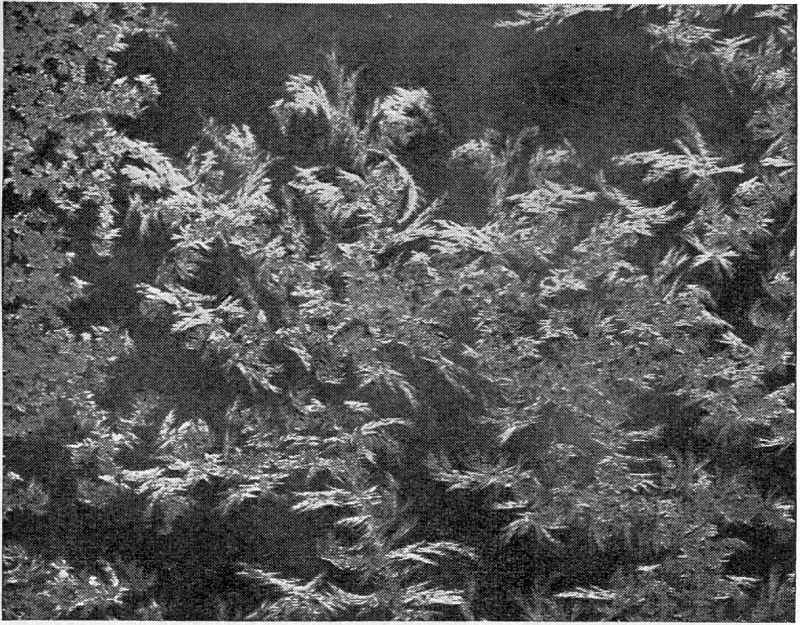
THE LOVELY FERN-PATTERN MADE BY THE FROST ON A WINDOW-PANE DURING THE NIGHT
How is snow made? It isn’t frozen rain, because that would come down as small hailstones. It is frozen water-vapour—frozen clouds! In winter-time the clouds often float through very cold air, and it sometimes happens that instead of turning into raindrops, as they usually do, they change from water-vapour into tiny ice-crystals. The crystals join together and make snowflakes. These are too heavy to float about the sky, so down they come. They are so soft and so light that, although there may be thousands of snowflakes falling around us, we never hear a sound.
Have you ever seen an ice-crystal? I should like you to see one, because I know you will be surprised at its lovely shape. To see crystals properly, you want a piece of black cloth. Catch a snowflake on it and look at it through a small magnifying glass.
You will see that the flake is made of tiny, glittering crystals—and every one of them has six sides! Catch as many as you like and count the number of points they have, and you will always find six, or a multiple of six. Some of the crystals are feathery-looking, some are star-shaped, others are plain—but all are exquisitely fragile and delicate.
Choose a day when there is not much wind when you catch your snowflakes, as otherwise they will be bruised by being blown about, and you will not be able to see clearly the lovely shapes of the crystals.
The snow acts as a warm blanket to the earth. Perhaps you are surprised to hear that something so cold should give warmth to things!
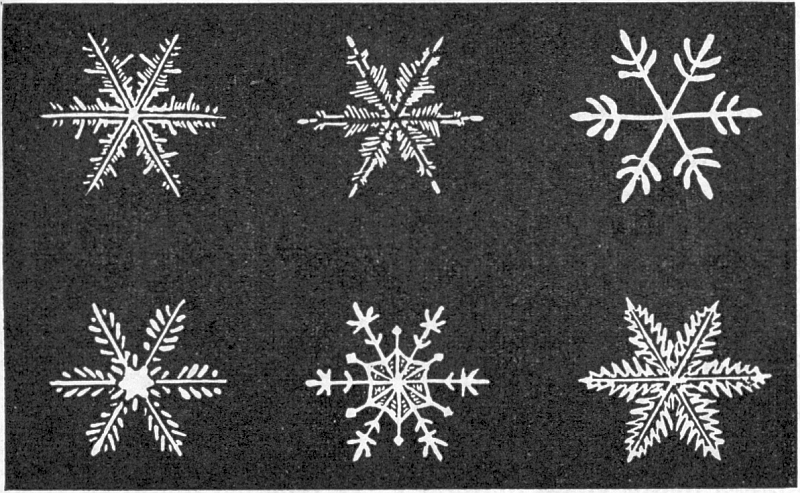
WHAT FROST CRYSTALS LOOK LIKE UNDER A MAGNIFYING GLASS. EACH HAS SIX SIDES
If you weighed a pound of water and compared it with a pound of snow, you would be surprised to see what an enormous amount of snow had to go to make up the pound, compared with the water. What makes snow so bulky? It is the air entangled in the snowflakes! Think of feathers, or of wool—each of those weighs very light, and a great deal of them has to be piled on the scales before the weight of a pound is reached. They, too, have air entangled in them. A little bird’s body gives out heat and warms the air in its feathers, and these keep the air in—and the heat too—so the bird is always warm, no matter how cold the outer air is. Its feathers entangle the warm air and won’t let it get away.
Fur does the same, and so does wool. And now, how does snow keep the earth warm? Can you think? It keeps it warm because it doesn’t let what heat there is in the ground get away! It holds it there, entangled in the six-sided crystals. The frost in the air above the snow may get harder and harder—but the bitter cold cannot touch the tender plants below the snow! The flakes are keeping their heat in, just as our woolly blankets at night keep our heat in, and make us feel warm.
When warmer days come, the snow melts and the plants drink their blanket! It trickles down to their roots and so is of use to them in another way.
Hoar frost is not frozen dew. The moisture in the layer of air next to the ground becomes frozen instead of turning into drops of dew. If we look at hoar-frost closely we shall see that it is a feathery layer of ice formed on blades of grass, twigs, leaves and so on. It is very beautiful.
When the weather is misty and very cold at the same time, the mist freezes, and we see that everything outside becomes covered with a thick layer of tiny ice-needles. This we call Rime.
When snow falls through air that is warmer than freezing-point it begins to melt—and we find that a mixture of snow and water is falling on us. This is called Sleet.
Hail is made of rain-drops frozen into balls of ice. As you know, hail-stones are very often far bigger than drops of rain, and this is because in their travels through very cold air more and more layers of ice have been added to each hail-stone, so that when at last they reach earth they may be very large indeed, and do a great deal of damage.
THINGS TO DO
The very first chance you have, catch a snowflake on something dark and look at it closely—with a magnifying glass if you can. Count its sides.
Draw a snow-crystal or a snow-scene.
How does the frost help the farmer?
How does the snow help the plants to face a bitter winter?
Why do our pipes burst in frosty weather?
Of course, you have all watched a snail creeping slowly along the ground, and thought of the saying we have when speaking of something slow—we say “At a snail’s pace,” don’t we? It is a curious little creature, carrying its house upon its back and leaving a silvery trail behind it.
The snail cannot help being always at home, because it is forced to take its house with it wherever it goes. Why does it do such a strange thing? It must be a nuisance to have to drag one’s home about always. No wonder the snail creeps along so slowly.
The snail has a very good reason for carrying its shell about on its back. Look at its body as it crawls along. It is very soft, and many birds and animals think it makes a delicious meal. To protect its soft body the snail grows a hard shell into which it can retreat when danger is near. Take up an empty snail-shell and look at it. Is it thick or thin, heavy or light, strong or frail?
It is light, thin, but very strong and hard. Even a thrush’s strong beak cannot peck through it. It is like armour for the snail.
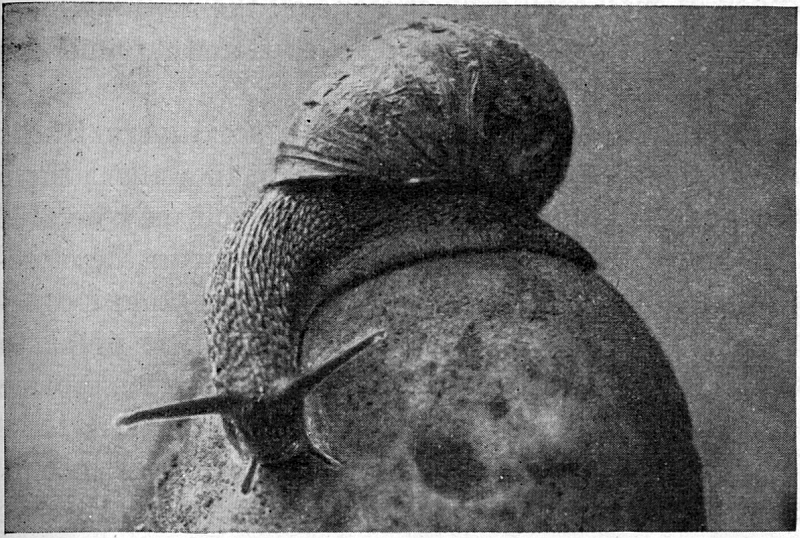
THE GARDEN-SNAIL GLIDING OVER A STONE. ITS HORNS ARE OUT, AND AT THE TIP OF THE LONGER PAIR ARE ITS EYES
The thrush is so fond of a snail for dinner that it has discovered how to defeat its armour. I have a very tame thrush in my garden called Freckles, who likes a feast of snails better than anything else. He searches the stones in my wall and my rockery each day, and sooner or later he finds a snail. He takes it in his beak to a big flint stone near the gate. Then he hammers the snail on the stone until the poor thing’s shell breaks and the thrush is able to eat the soft body inside. Then off he goes once more to seek another snail, and sometimes I hear the little knock, knock, knock of snail-shell against stone all the morning long. Dozens of pieces of shell are scattered around his anvil.
In the morning you will often see silvery tracks in your garden, and you say, “A snail walked there last night!” Follow the track and you may be able to find the snail hidden under a stone or in the close-growing ivy. A snail likes to keep the same hiding-place for itself, and when it comes out at night to search for food it will always return to the same place afterwards. I have sometimes marked snails I have found with white chalk or black ink, and sure enough they returned to the same places week after week. Would you like to do the same?
How does the snail make its silvery trail and why? It is made of slime from the snail’s body, and the snail finds this very useful. Its body is soft and the ground is rough and hard. The slime acts as a sort of carpet to protect the underpart of the snail from being hurt. What a strange little creature it is, carrying its house upon its back and laying down a carpet to creep on!
Where are the snail’s eyes? Can you see them? Wait until it creeps out of its shell, and then look at the two pairs of “horns” on its head. The smaller pair are feelers. The larger pair carry the eyes—right at the very tip! Look carefully and you will see them there. They are not very good eyes, because the snail does not really need excellent eyesight, for, as we have said before, it comes out mostly at night.
It takes great care of its two eyes, however. If danger is about, the snail hides away its tiny eyes. Where does it put them? It turns its big pair of “horns” outside-in and stows its eyes at the bottom! How does it do that? Well, you can easily see what I mean by taking a glove-finger, putting a big pin in at the tip so that the pinhead represents the eye—then put your thumb and finger inside the glove, take hold of the end of the pin and pull. The finger turns inside-out—or, rather, outside-in—and the pin-head goes to the bottom. That is what happens to the snail’s eyes when it “puts its horns in.” Touch the horns and watch them roll inwards, and you will see exactly what I mean.
I do not need to tell you what the snail eats, do I! I am sure that anyone with a garden will groan and say, “Lettuces! Cabbages! Young plants!” It is a most destructive creature—a perfect nuisance in a garden. If we could see it eating we should know why it can destroy leaves so easily.
Perhaps you have a bit of cabbage you can give your snail to eat. If it is hungry you may be able to hear a curious little rasping noise, which is the snail’s tongue filing off the leaf! It has a ribbon-like tongue set with thousands of hooked teeth, and these act like a file, rasping to and fro over the leaf. When the file begins to wear out at the tip it grows at the root, and so is always long enough for use. Have you a file in class to see? Look at it, and you will know why the snail can damage a plant so easily and quickly.
The long, soft body that comes out of the shell and on which the snail creeps is called the foot. Look at the right-hand side of the snail near the shell and you may be able to see a little hole or slit opening and closing. That is its breathing-hole.
The snail always leaves some of its body inside its shell when it moves about. It grows there and cannot be removed without tearing. If the snail gets a dent or little break in any part of its shell it gradually mends itself. A new little patch of shell slowly grows in the place of the broken piece.
The snail does not like the frost. It is afraid of being frozen, and so, when cold days come, it finds a safe hiding-place and then seals up the opening to it’s shell to prevent the cold from getting in. It closes it with a thick lid of hard slime, leaving a tiny hole for breathing. It does not creep out again until the frost has gone, warm weather is here, and there are plenty of new young plants growing everywhere for it to feed on. Then it opens its door once again and walks out for a good feast.
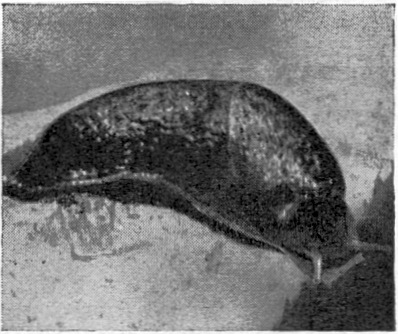
ONE OF OUR GARDEN ENEMIES—THE BIG BLACK SLUG
The slug is the snail’s cousin. It has no shell like the snail, but under its skin, behind its neck, you may find a hard piece, like a small flat shell. Some slugs have no hard piece at all, and all slugs have to be much more careful about their hiding-places than snails, because they wear no armour. They are covered with sticky slime and are most unpleasant to touch. Like snails, they love wet weather, because then the ground is softer to their bodies and they can crawl about easily, using little of their own slime. With their rasping tongues they do even more damage than snails, and a dozen may completely destroy a row of young lettuces in a night.
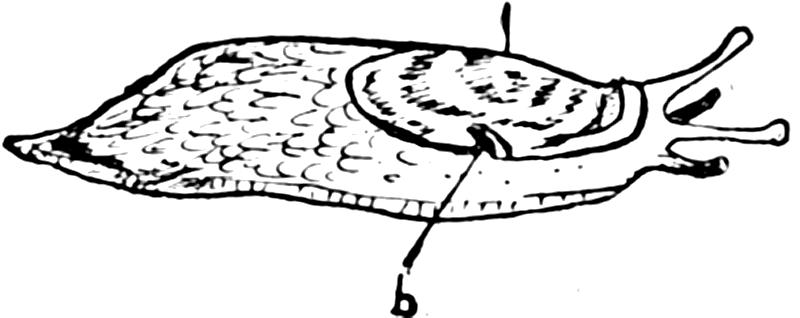
a. SHELL OF SLUG
b. BREATHING-SLIT
Perhaps in your gardening you have come across little batches of tiny white eggs, two or three dozen together. These are snail eggs. If they are rather jelly-like they are slug eggs. The robin who sits by me when I garden flies down to eat them when I turn them up, and I am glad to see him do so, because I know that there will be so many snails or slugs the less to eat my lettuces and my cabbages!
The tiny snails hatch out of the eggs complete with their shells, and soon grow as they feed ravenously each night on tender young plants. They go on growing for about three years, when they are full-grown, and they lay hundreds of eggs each season.
Would you like to keep a snailery for a few weeks? It is rather fun. Get a box and put into it some damp earth, some grass, and some fresh leaves. Then put your snails in. Cover the box with a piece of muslin. You can now watch them eating, creeping and resting. Put fresh leaves in each day, of course. If you put your box outside on the window-sill for a few cold days you will see how the snails close up their shells with a hard little door.
THINGS TO DO
Look for snails in the park or in your garden, and find out where they like to hide.
Look for a thrush’s anvil, and if you find one watch for the thrush to use it.
Make a snailery of your own at home in a shed. (Your mother may not like the snails in the house.)
Draw a snail in its shell. Draw a snail creeping along.
Where are a snail’s eyes?
Why does a snail leave a silvery track?
How does a snail eat?
This winter we are going to make friends with the birds. We shall never know them really well unless we can bring many of them near enough to watch their ways and hear their calls. We shall have an interesting and exciting time, and you will have many a tale to take home with you in the winter.
A great many of you, I know, already have bird-tables in the winter-time, but a much larger number have nothing at all to attract the birds to your school. Even if you are a school in the heart of a town you can still bring numbers of birds to you, so please do not think that this lesson is only for the more or less country schools. It is for all and every school, and it does not matter in the least whether you know anything about the birds or not—you soon will!
The first thing to make is a bird-table, on which you can spread all kinds of different food for the birds. You can make this as simple or as elaborate as you wish. In its simplest form it is merely a square piece of wood nailed on to a post or pole out of the reach of cats. Put it as near your window as you can, because you will naturally want to see the birds closely.
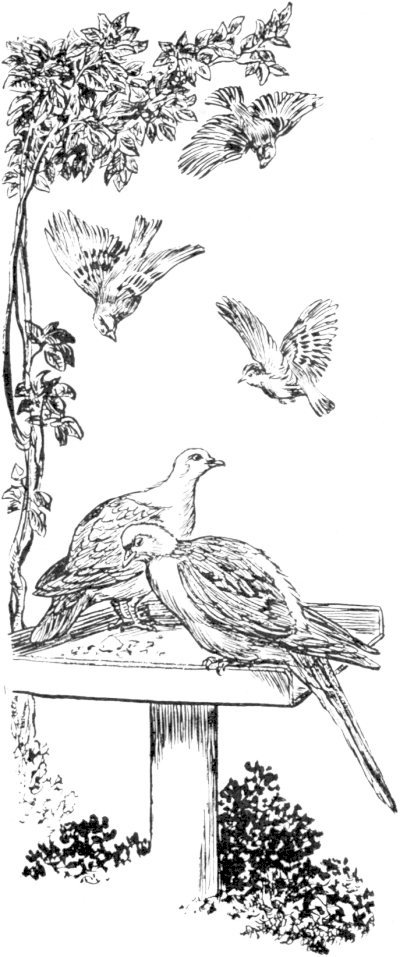
There is sure to be someone in the class who likes making things with wood, and it won’t be long before your table is up in its place. I have a rim round mine to prevent the food blowing off on a windy day, but otherwise it is simply a pole stuck in the ground with a flat piece of wood nailed on the top. One of the sides has no rim, as I like to scrape the bird-table each day to rid it of stale food or bird-dirt, and it is easy to scrape it off the unrimmed side with a piece of wood, the scrapings falling into a shovel or piece of newspaper. Once a week or once a fortnight it should be well scrubbed with soap and water to keep it clean.
Now we will imagine that your bird-table is up, not far from the classroom window. There it stands, ready for its visitors. What shall we put on it to attract them? Think hard and make a list of the food you know the birds will like. We cannot give them worms or insects, but there are plenty of other things we can bring from home, and many others we can go out and collect from the fields and lanes.
What have you put on your lists? Bread, I am sure! Most birds will eat that. Shall we begin with that? Soak it in water if it is stale and hard, and then put it on your table. Who will come for it first? Watch and see.
It is almost certain to be a bold sparrow. He spies it from the roof of the school and knows it to be bread—but he hasn’t seen it in that place before. He must go warily, in case it is some sort of trap.
After a while down he comes to the ground. He is not going to sample that strange-looking table yet. Perhaps there are a few crumbs underneath he can have. Yes, there are! He pecks them up, and then cocks his head on one side, looking up at the table. Dare he fly up? No, he really doesn’t think so! Suddenly down fly two or three more sparrows, and begin to hunt for crumbs underneath the table. They have seen the first one, and know that food is about. This decides the sparrow—he had better fly up to the table before the others have a look in; and up he goes perkily, and is soon feasting on our soaked bread. The others join him, and there is our bird-table with quite a crowd on it within the first hour!
We may get a robin that day, too. He prefers to feed alone. He does not like the company of common sparrows, so he chooses a good moment and then flies daintily down to feast. He sings a few creamy notes, and then flicks off again. But he will come again to-morrow. He has made up his mind that it is his table, put up mainly for him, and he will make himself quite unpleasant to the other birds there! He loves to be friendly and tame with us, but to his own kind he is stand-offish and not very polite.
If we put out only bread we shall not get very many birds besides the soft-billed or insect-eating birds. These, like the robin and thrush, feast on worms, slugs and insects—soft food. Other birds, such as the chaffinch and bullfinch, feed on seeds or grain, and they are called hard-billed birds, because they like hard food. We must remember them, too—so we will put out seed for them, and see who comes for it.
The sparrow, a hard-billed bird, will eat practically anything, so he will devour bread or seeds with equal greediness. We will buy some hemp seed at a seed merchant’s and put a little on the table. How the sparrows enjoy it! And see, here comes a smart little bird, looking as if he has just had a wash and brush-up! His chest is rosy, and his head slate blue. His wings are boldly barred with white. He pecks up the seeds rapidly, and we say, “Look! There’s a chaffinch!”
We may get greenfinches, bullfinches, hawfinches as well, to feast on the seeds provided. I cannot tell you how to recognise them all, but you will find a book of birds with coloured pictures very useful to you. You can also buy coloured postcards of birds, and pin them on the wall. Then you will soon learn to know the birds that come.
Here is a list of food you can put on the table, besides the soaked bread and hemp seed. Any of these: soaked dog biscuit, scrapings of porridge, cold boiled potatoes (a potato in its jacket will be a great treat sometimes), scrapings of milk pudding or suet pudding, most household scraps (not fish or cabbage), currants, fat or suet, a meaty bone, bacon rinds, cheese rinds. Also you must keep your eyes open when you walk in your garden or out in the county, and bring back with you hips and haws, elderberries, blackberries, rowan berries (mountain ash), privet berries, ivy berries (in the New Year when they are ripe), yew berries and honeysuckle berries. Please remember not to eat any berries strange to you, as most of them are very poisonous. The yew berries, for instance, loved by the birds, are deadly poison to us and to animals.
Then you can collect green food for the bird-table, such as groundsel or chickweed. You can save old sunflower heads and hang one from the side of the table. You can collect the seeds of poppies (wild), plantains and shepherd’s purse, and save them up for later on, when the birds will be glad to have them on the table. Pick thistle, dandelion and knapweed heads, and you will find that your bird visitors, especially the greenfinches, will be delighted to feast on the seeds.
I usually nail some branching twigs to the back of my bird-table, as I like to see the birds perching on them before hopping down to the food. You can tie your bunches of berries, thistle heads and so on to these twigs. You will probably find other food, such as ash keys, which you can dry in the sun and put away for later use, when you will not be able to find so many things in the fields for your bird-table.
Bring your household scraps to school, unless you are going to use them on a bird-table at home. If you have an old cardboard cream-carton or jam-carton, you will find it is a good plan to get your mother to put into it each night the leavings of the day. Then you can take them conveniently to school in that. Any bigger leavings you had better take in your seaside pail!
On your table please put an enamel saucer of water, and fill it afresh each day. The birds will be so thankful for this in frosty weather, when all the ponds and puddles are covered with ice. If anyone has an enamel dish she can spare and will lend it for a bird-bath, many of the birds will be delighted to take daily baths under the bird-table.
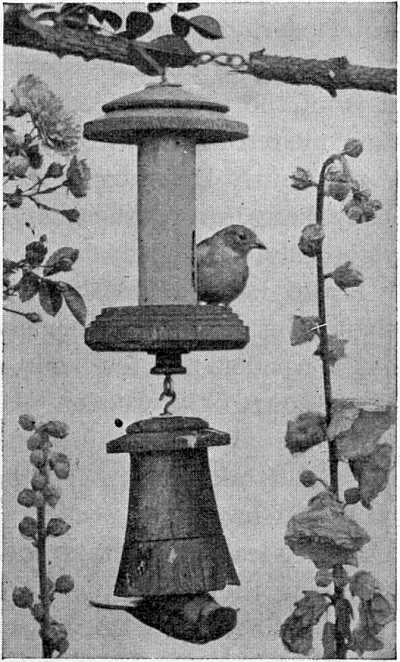
FOR THE TITS
The seed-hopper, and, below, the tit-bell, full of fat.
I have two splendid things in my garden for the tits. They are a tit-bell and pea-nut feeder, and are hung 6 ins. away from my window. The pea-nut feeder is simply two thick circles of wood, top and bottom, with a cellulosed barrel in which slits have been cut. The tits, woodpeckers and nuthatches feast greedily on the nuts by pecking at them through the slits. There is a cork at the bottom of the feeder, and I put my shelled monkey-nuts in there, then cork it up again. Do have one of these, they are such fun!
Now look at the wooden tit-bell, under the pea-nut feeder. If you peeped inside this you would see that it has a rod across and nothing else. I unhook it from the pea-nut feeder, turn it upside down and pour melted fat into it. When it has set solid I hang it up again. Down come the tits to feast on my bell! They hang on to the perch inside and peck away vigorously.
I also have a seed-hopper for the great-tits and chaffinches. This is rather like the pea-nut feeder, but has a wooden box for hemp seed. The box part fits loosely on to the wooden platform below, and a few seeds are always leaking out. The birds soon find these and take them. To their surprise and delight, no sooner have they pecked up the loose seeds than a few more leak out to take their place! So, no matter how long they feed, there are always seeds for them there. When there are no seeds left in the box I fill it again.[1]
|
Enquiries concerning tit-bells, etc., should be addressed to Mr. Mortimer Batten, Naturalist, of Pencaitland, E. Lothian, N.B. |
You will perhaps think I have forgotten to say anything about coconuts for the tits. I am sure I do not need to say very much, because so many schools have hung up a coconut by the classroom window and have watched the tits feeding on it. It is best to ask the greengrocer to knock a hole in each end for you, and hang up the whole coconut rather than cut it in half. If you do cut one in half, hang the halves upside down, then the rain will not collect in the hollow and turn the nut bad.
If you buy monkey-nuts and thread them on string to hang from the bird-table, the tits will be delighted. They will hang on to the nuts and peck them vigorously, and you will find that very soon there is nothing but a string of empty shells! (See picture on page 93.)
THINGS TO DO
Feed the birds at home as well as at school. Put out a saucer of water for them.
Make a bird-chart, and put down on it the birds that come to your table and what food they take.
Collect berries and seeds for the table, and take them to school for use now, or for storing until later.
String some monkey-nuts and hang them in your garden at home.
Find each bird visitor in a book about birds and read all about it. If you can find any good coloured bird pictures in magazines, or on postcards, put them up on the wall for everyone to see.
Write down (a) the food the robin eats from the table, (b) the food the starling eats, (c) what the tits seem to like the best, and (d) which birds eat the seeds.
Scrape the table clean each day, and put out fresh water.
We have learnt how to tell which wind is blowing, we have perhaps made wind charts, and we have learnt about the sun and its movements. So I hope we are beginning to know something about east, west, south and north and could find our way in any direction we were told to go.
Supposing I said to you, “Go out of the school gate. Turn east. Walk until you come to crossroads. Turn up the one that goes northwards. Go down the first turning that runs westwards, and walk until you come to a road running to the south.” Could you do this? Or, when you were outside the school gate, would you feel quite puzzled as to which way you should go?
If there were a weathervane or weathercock in your school-playground, you could, of course, tell at once which way to go, couldn’t you? What would you do? You would simply look for east on the points underneath the vane or cock, and turn in the proper direction. Then you would know that at the crossroads you must turn left, for that would be northwards. Take a piece of paper and quickly trace out the way you would go. (One of you should do this, on the blackboard if you can.)
But suppose you had no wind-vane to guide you and you really didn’t know which was east, west, south or north! You could still find your way if the sun happened to be shining.
You know that on these spring mornings the sun rises in the east, and in the evening it sets in the west. In the middle of the day it is at its highest point in the south. Therefore, if it is morning, you would know that the eastern direction is towards the sun; and if it is evening, you would have to turn your back on the sun in order to journey eastwards.
So, if you looked at the sun when you went to the school gate it would tell you whether to turn left or right in order to go east.
Suppose it were night-time and you could not see a wind-vane (and, of course, the sun would no longer be in the sky). What could you do then? You could, if you knew how to, tell which way to go by looking for a fairly bright star which is always in the north. I will tell you about it, because you may like to find it yourself to-night.
This star is called the North Star, or the Pole Star, because it is almost overhead at the North Pole. This is how to find it: look in the northern sky for the group of stars called the Great Bear. I will draw them for you, then you will know the shape they make in the sky. Some people think they make the outline of a plough rather than the shape of a bear.
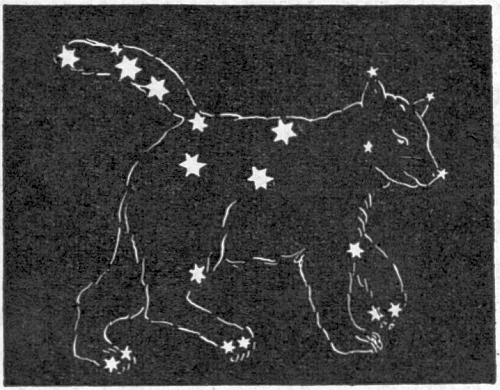
THE GROUP OF STARS THAT MAKE UP THE GREAT BEAR
Another name for this group of stars is “Charles’ Wain.” Wain means wagon. Look at the shape of the group. Can you see what might be a wagon (four stars) with three horses in a line? Now take the two stars at the back of the wagon (called the Pointers) and join them by a straight line, using your ruler. Continue your line, and you will find that it runs to another star, some distance away—that is the Pole Star, which is always in the northern sky. (Can you do this on the blackboard?)
Ask someone who knows, if they will point out the Great Bear, or the Plough, or Charles’ Wain to you, one night. Then let your eye run in a straight line from the Pointers, and you will at once find the North or Pole Star shining. It will tell you which is the north, and you can then find out south, east and west quite easily. Sailors use the stars a great deal in their voyages, and the sun, too, to help them in sailing in the right direction.
But now suppose that you have no wind-vane to help you, and the sun is quite hidden behind clouds. How will you know which is north, south, east or west? You will not know—unless you have a compass!
I expect you have all seen a compass. Have you one in class? Look at it. It has a needle inside that swings easily over a card on which are printed N, S, E, W, NE, NW, SE, SW and other points also. Turn the compass round and then set it down. The needle swings about, and at last points—where? To the door? To the window? To the blackboard? It will differ in every schoolroom. Find out where your compass needle points when it comes to rest.
Now turn the compass round again, and let the needle swing once more. What a strange thing—when it comes to rest it still points in exactly the same direction as before. It does not matter how we turn the compass, the needle will not come to rest in any other position than the one it chose the first time.
What direction is that? Who knows? Yes, it points always to the north.
The needle is a magnet, and magnets like to point to the north when they are free to swing. And a very useful habit it is, because by using magnets like this one we have in our compass, sailors, travellers and airmen are able to find their way about in strange places, when the sun and the stars are hidden.
Perhaps you would like to know a little more about magnets. Your teacher has a large horseshoe magnet. What will it do?
It will attract to itself things made of iron or steel. Put a sewing-needle near the magnet and see it jump eagerly to the magnet and stick there even when held up in the air! Try a steel knitting-needle. That will be firmly held by the magnet too. Look at it holding it to itself. Try to pull it away. Do you feel the magnet pulling at the needle, almost as if it were alive?
Now look what a queer thing has happened? The knitting-needle is attracting our little needles. It has become a magnet too. See how the small needles are hanging on to the knitting-needle, which is, in turn, being held by the magnet!
Try other things with the magnet. Does it attract your penknives? What about the sewing-scissors? Try it with brass drawing-pins. How disappointing! It takes no notice of them at all. They are not made of iron or steel, you see.
Look at the little needles hanging on to the magnet. They are magnetised now. Rub the magnet over a needle (stroke it several times, always in the same direction), thus making it into a little magnet itself. If you could put it into your compass, instead of the needle that is there now, you would find that your little needle would act like the compass needle—it would swing round to the north, and point there!
But our little needle has nothing to swing on. Can we do something with it so that it may swing easily? Do you know what the long-ago people did with their needle magnets before they found out how to set them on pivots, like the one in our own compass? They used to float their magnetised needle in water, and then it would swing round to point to the north.
Try floating your needle magnet in a basin of water. Put it gently on to the surface of the water. It floats beautifully, and as it floats it twists round slowly. Where is it pointing to when it comes to rest? To the north, of course! (Needles will only float if quite dry; a slight rub with vaseline helps them to float.)
When people found out this strange fact they thought how useful it would be to put one of these needles into a box, and use it to help them in finding their way, especially over the sea, and that is how we came to have our excellent compass. It was more and more improved, and those made for big ships and for aeroplanes are most interesting to see.
If we take our compass to pieces, we see that the needle rests on a pivot, which allows it to swing easily from side to side. Let us take off the card and make one of our own.
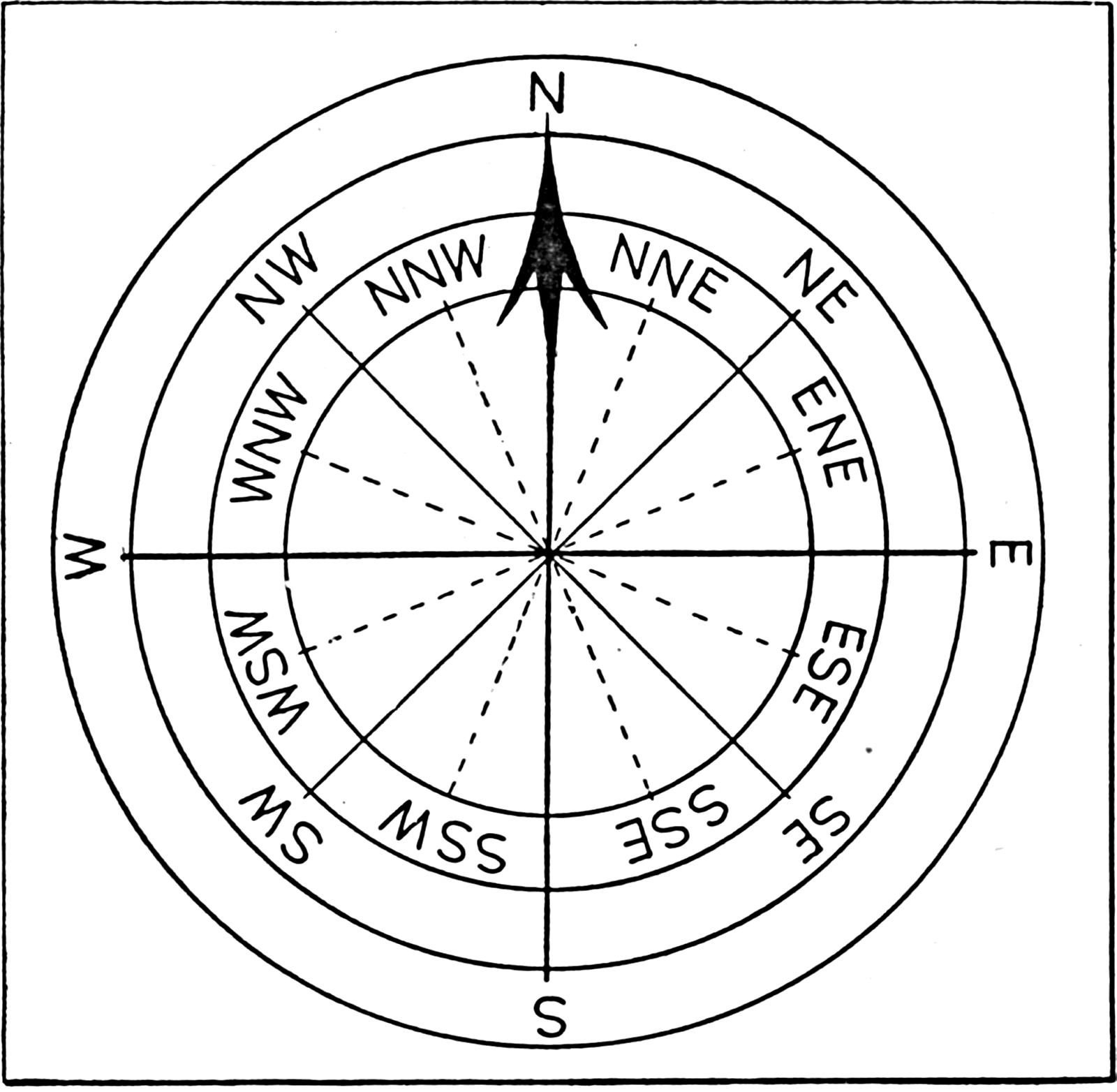
CAN YOU MAKE A COMPASS CARD LIKE THIS?
We can each make a compass card for ourselves if we want to. Cut out round pieces of card, as large as you can. Draw a thick line across your circle, halving it exactly, to show the north-south line. Now put N. for North at one end, and S. for South at the other. Now you must draw the east-west line, right across the first line. Your circle should now be in four quarters. Letter in E. and W. at the correct ends.
Now draw thinner lines between the lines you already have, for N.W., N.E., S.W., S.E. You now have eight points of the compass, haven’t you? Now we will have even more lines, in between all the lines you have. Make them dotted lines this time, and letter them, in their correct positions, N.N.W., N.N.E., W.N.W., E.N.E., W.S.W., S.S.W., E.S.E., S.S.E. Can anyone get them all right without help? You will have to think hard, but I expect some of you will be able to fit in all the lettering correctly.
THINGS FOR YOU TO DO
You know where North is. Set your card on your desk with the N. line pointing north. By the help of your card put down in what direction are—the door—the blackboard—your best friend—the fireplace—the biggest picture in the room—a vase of flowers—and a cupboard.
Now go out into the playground. Choose six things there and find out what direction they are in when you stand with your back to the school. Be sure you have your card set right by means of the compass.
What can you see from your school playground? Can you see the church? In what direction does it lie? Can you see a tall factory chimney? Or a big hill? Find out the directions from either the compass, or your compass card.
Make a little plan of how you come to school; put an arrow showing the north.
Soon we shall be thinking about our Christmas decorations. We shall order our holly and mistletoe, go to choose a big or little Christmas-tree, or walk into the country to find ivy and laurel or branches of other evergreens to decorate our homes and schools.
Why don’t we use the prettily shaped oak-leaves for decoration, or the shiny beech-foliage? We cannot, because those trees are bare, and save for a few russet leaves still clinging to the oak there is nothing to be seen but empty boughs.
So we must choose evergreens for the winter-time, especially those with berries, because they give colour to the dark leaves and make the branches gay. And for our Christmas-tree we must choose an evergreen, too, for the dark-green branches make a fine background for our bright toys and candles.
We all know the Christmas-tree—but who knows its real name? Not one of you, I expect! Its real name is the spruce fir, and the tree itself grows to a great height. Have you ever seen one in the woods?
It is a very straight, soldier-like tree, with a reddish-brown bark. Slender branches grow straight out all round its trunk, the lower ones sweeping downwards, gracefully, curving up at the tips. The branches get smaller and smaller up the tree, making it pyramid-like in shape, and at the very top is one spear-shaped branch sticking straight upwards. Look for this when you are hunting for a full-grown Christmas-tree.
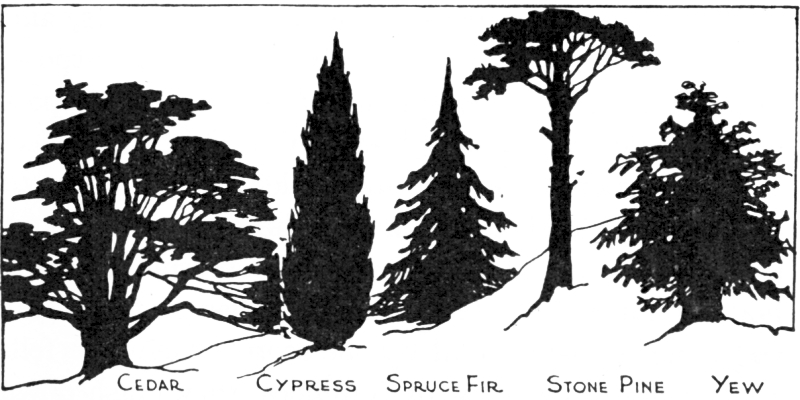
You all know what the leaves are like, for you have seen them often at Christmas-time. They grow so neatly along the twigs, and always look to me as if someone had been along with a brush and comb and made a trim parting down the middle of the sprays! You may find some full-grown fir-cones hanging down from the branches, and if so you must look for the seeds so carefully hidden inside.
Our telegraph posts are made of the trunks of full-grown Christmas-trees. So are the scaffolding poles that are used when men are building the upper part of a house. Our ships often have spruce-fir masts, and the fine, straight poles are excellent for that purpose. Look carefully at telegraph posts next time you pass them, and you will see then how very straight the spruce-fir tree must grow to make such splendid poles.
In Switzerland and Norway the spruce firs grow in great forests. They do not like storms, because they are not deep-rooted trees, and when a strong gale blows the spruce firs fall by the score. One tree fells another, and, like a row of dominoes, they crash down in the forest, making a broad alley through the wood. If we have a big storm this winter, look closely at the trees that fall, and you will be sure to see that some of them are spruce firs.
Our Christmas-tree is a young spruce, only a few years old. Plant it in the garden after you have used it for Christmas, stamp the earth down firmly, and maybe the tree will root itself in and grow.
We all try to have holly at Christmas-time, and the old custom began so many hundreds of years ago that we really are not sure how or why it started. From ancient times it was used to decorate our churches and our shrines, and it gets its name, holly, from the word holy. It has always been the holy tree. Another old name is the holm tree, and wherever the holly grew in woods it gave its name to the villages or countryside there. I have been to Holmwood, where there are hundreds of beautiful holly trees, and you may be able to think of other villages to which the holly gave its name. Holmsdale and Holmbury are two more.
You know the holly so well that there is no need to tell you what it looks like. You have all seen its dark-green polished, prickly leaves, and the bright red berries that shine so brightly.
Have you seen the holly tree growing? You may see it as a hedge, a bush or a not-very-large tree. It is an easy tree to know because of its thousands of prickles. Why are they there? Most of you know, I am sure. They are to prevent animals from feasting on the leaves. Sheep and deer like the taste of the tough holly-leaves, so the tree has to find some way of protecting itself. No animal likes to hurt its tender tongue, so the holly is safe from greedy enemies.
At the top of the tree, out of reach of animals, are quite different leaves. They have no prickles at all. This is not very strange, is it? You can all guess the reason for that. Put a prickly leaf beside a smooth-edged one. You might think they had come from different trees!
You must look for the holly flowers in the spring-time. You will find them growing where, in the winter, the berries appear—tucked between the leaf-stalk and the twig. At the end of summer the faded flowers have gone and in their place are small green berries, which turn to yellow and then to the bright red we know so well.
The mistletoe, which we hang up with the holly, is a strange plant. It is a thief, because it steals from other trees. Have you ever seen it growing? I have. Not far from my home is a group of black poplars, and in the winter-time, when the trees are bare, I can see strange-looking bundles high up in the branches. They look like tangled birds’ nests, but they are mistletoe plants growing on the trees!
I will tell you exactly how the mistletoe starts its curious life. Perhaps one day a mistle-thrush finds an old spray of Christmas mistletoe thrown on the rubbish-heap. He is very fond of the pearly berries, so he feasts on them. The berries are sticky and the seeds inside stick to his beak. He flies up to a tree, and cleans his beak by rubbing it against a branch. Off he flies, leaving on the tree the seeds of the mistletoe.
Then the seed sets to work. It sends out a little root called a “sinker” right into the branch of the tree. This sinker is trying to get at the sap, because it wants to feed on it. When at last it reaches it, it steals it for its own use, and soon two small leaves appear on the bare branch. The mistletoe is growing!
More and more sinkers are sent down into the sap, and more and more leaves grow, until at last there is a big bush of mistletoe, its pale green leaves dotted with half-transparent, pearly berries at Christmas-time. Because it steals from others, we call it a parasite—one who lives upon another. If we cut the whole bush away from the tree it will grow out again—for, without injuring the poplar-tree itself, we cannot cut out the sinkers that the mistletoe has sent down into the poplar’s branches to steal some of the poplar’s sap for itself.
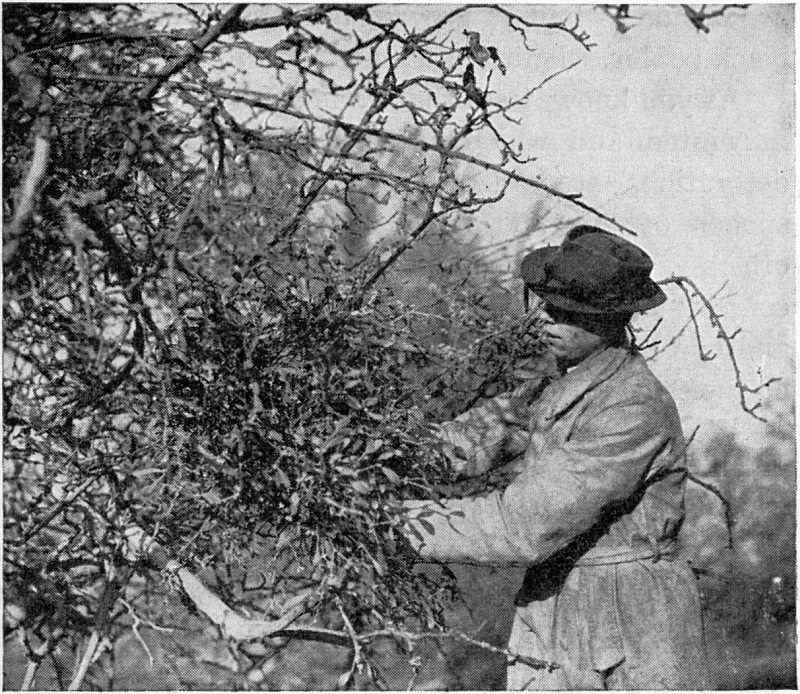
GATHERING MISTLETOE FROM AN ORCHARD TREE FOR USE AT CHRISTMAS-TIME
You may find it growing on apple, lime, oak or black-poplar. Isn’t it a strange plant?
As you know, trees that do not drop all their leaves in winter, and which we can therefore use for our decorations, are called evergreens. We have already spoken of three. Now let us make a list of some others. Who can think of the most? Privet, of course, laurel, ivy, box—what else? Yes, pines—and cypress, yew, juniper and cedar. Those who live on the south coast may add the bay-tree, too.
We all know the privet hedge which keeps green all the year through. But do you know the white flowers, which look rather like tiny white lilac sprays, but have a coarse, strong smell? We clip our hedges so much that usually our privets do not flower. If they do, we may see the purple-black berries now. Put some on your bird-table and see if the birds will eat them.
Up trees and over walls the ivy grows, clinging tightly to its support. Its stem cannot stand upright by itself, so the ivy must find something to help it. How does it manage to cling so fast to tree-trunks? If you tear away a bit of ivy-stem you will see scores of small white roots growing into the trunk. They are not like the sinkers of the mistletoe, because they do not steal the sap from the tree—they simply cling to it. But although the ivy does not steal sap, its leaves steal light and space, and many a fine tree has died, choked by the strangling ivy. We should never let ivy creep up our trees.
Behind the thick, strong ivy leaves hide many little creatures—snails, flies, wasps and others. In their shelter are built many nests. Press back the five-pointed leaves and see how dry and sheltered the trunk or the wall behind is. When rain comes the drops trickle down from one ivy-leaf to another till they reach the ground—and in the ground you will find the ivy’s real roots. Look and see.
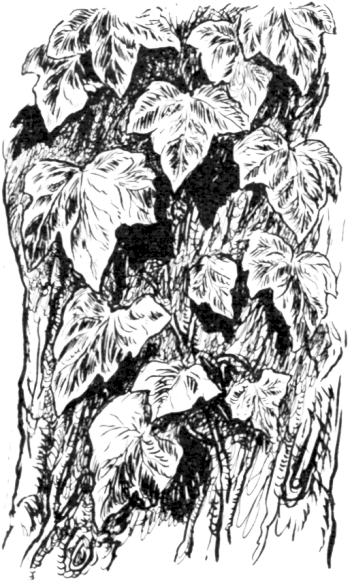
IVY GROWING ON THE TRUNK OF A TREE
The laurel we know best is the big bush in the parks or shrubbery. It has big, tough, shiny leaves, and you will find dark purple berries among them. It is an ugly, gloomy plant, and seems to say to animals and children, “Keep off! I am poisonous!”
The true laurel is the bay, and you may have seen it made into arbours or arches, or grown in tubs as a tree or bush. Its leaves have a very fragrant smell.
You may know the Scotch pine by its curious needle-like leaves, which grow in pairs, joined together at the base. Look for the old cones beneath the pines and see the woody scales behind which the winged seeds lay before the wind carried them away.
The yew you will often find growing in churchyards, and you will be surprised to see that its trunk seems made of dozens of little trunks, all growing closely together. From its wood were made the famous bows used by our soldiers before gunpowder was known.
You may never have seen the cedar, but you cannot mistake it when you do see it, for its branches spread out like flat, dark shelves, with big spaces between them. It grows to a very great age. You will find that the famous Cedars of Lebanon are mentioned in the Bible (1 Kings vii., 1-12).
THINGS TO DO
Draw a holly leaf. Draw a privet leaf.
Go and look under a holly-bush and find some “skeleton” leaves. Bring them to school.
Find some pine-cones or fir-cones and bring them to school to burn on the fire. They will smell nice.
Write down the names of six evergreens and the names of six trees which are not evergreens.
Draw a Christmas-tree with presents on and put underneath it its proper name. Look for a full-grown Christmas-tree next time you go for a walk.
Write down three things about the mistletoe.
Save some mistletoe berries at Christmas-time and press the seeds into crevices in the branches of apple, oak or black-poplar. Watch to see if they grow.
In this chapter I am going to tell you about two more of our common birds—the robin and the wren. One you will have seen on your bird-table. The other you may never have seen at all, and yet he is as common as the robin, though not so friendly.
We will talk about the robin first. I hope that you have been looking at him carefully when he visited the food you put out for him. Did you see how bright his red throat and chest were? Did you notice the pretty blue line that ran round the red? Did you smile to see how bright and bold his black eyes were?
It is no wonder we like the robin better than any other bird, because he is so very friendly and tame with us. He is not very polite to his own world, for he does not care to mix with sparrows, thrushes, or chaffinches—or robins either for that matter! He likes to be with us. He enjoys himself thoroughly when we are gardening, because then he can eat the little worms or grubs our spade turns up. He will perch on the handle of the wheelbarrow, or sit on the watering-can—just to show us that he really is helping us and being friends. He bobs up and down, flicks his wings, hops to and fro, and does everything he can to attract our attention. “I’m here!” he says. “I’m here! Just give me a chance and I’ll be your very own robin!”
When autumn comes, and chill winds begin to blow, the robin chooses his winter home. Shall it be this garden, or that? Shall it be in the farmyard or in the lane? He makes up his mind, and then he sings a loud song, which says: “Oyez, oyez, this garden is my place, and no other robin is to come near, on pain of death or a fight!”
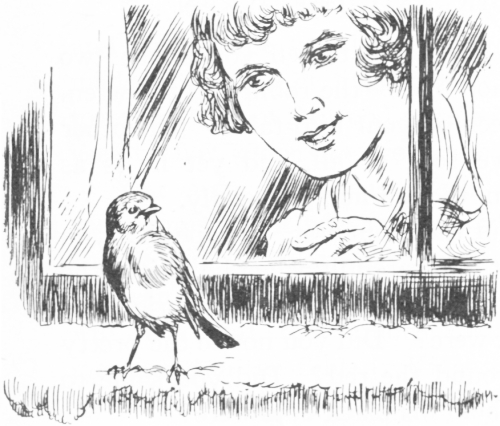
“I’M HERE!” HE SAYS
Perhaps another robin does come, and then there is a fight! Not much harm is done, usually, and the defeated robin flies away to find another winter home. Don’t you think that it is quite a good idea really, for every robin to have his own “beat,” and to find his own food there? Of course, other robins trespass now and again, but you will find that the one you see most often in your garden is the same robin, day after day.
He will become very tame indeed if you will let him. If you put crumbs out on the same window-sill each morning, he will be bold enough to peck sharply on the window-pane if you forget! He will come into the house if no cat frightens him, and will even take biscuit or bread from your hand or mouth if you keep still enough and are patient. I have often trained robins to do that, and people are so surprised to see it! But anyone can tame such a friendly creature if only they will try.
When spring comes the robin finds a wife, and how he sings to her! Have you heard the robin singing? He is singing beautifully now, for he is one of the birds that sing nearly all the year round. His song is very rich and creamy and quite loud. Once you have heard him and seen that it is a robin singing you will always be able to know his song.
In spring he and his wife hunt for a good nesting-place. Where shall it be? Somewhere low down, for the robin prefers to nest near the ground. If he can, he likes to put his nest into something that belonged to his great friend, Man. If he can find an old kettle or saucepan, a rusty tin, an old worn shoe, he will choose it with delight. One robin built his nest in the hat on a scarecrow’s head! Sometimes he will build it on a shelf in an outhouse of ours. It isn’t near the ground, but it belongs to us, his friends. If he finds nowhere really suitable of that kind, he will choose a bank or a hole in the wall.
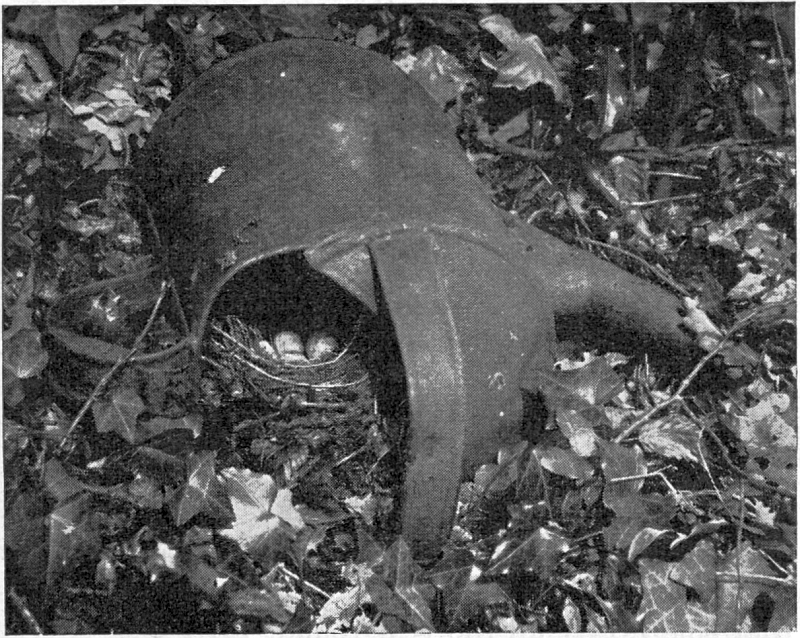
[Eric Hosking.
A ROBIN’S NEST IN AN OLD WATERING CAN
He builds rather an untidy nest, but a very comfortable one, with plenty of dead leaves and moss to make it soft and warm. If there are dogs, cats or cattle near, the robin hunts for their cast-off hairs and weaves those into his nest, too. Then his wife lays five or six grayish eggs, freckled with dull red, and sits on them. When they hatch they grow into pretty little fledglings with speckly brown breasts, not red ones. They will not get their fine red waistcoats until the following spring. Did you know that? If you see a robin-like bird in your garden with a speckly vest instead of a red one you will know it is a young robin.
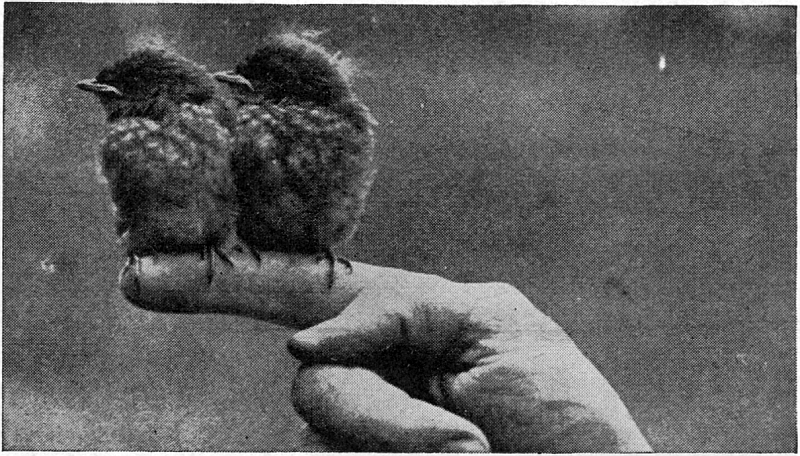
TRY TO TAME THE ROBIN IN YOUR GARDEN. HE IS LONGING TO BE AS FRIENDLY AS THIS!
When autumn comes again the family splits up, for the father robin knows there will not be enough food in one small place for so many beaks. This means many fights, of course, for the children want to stay in the spot they know. But soon all are settled somewhere and are eager to make friends with the people near by.
Tame the robin in your garden if you can. Take crumbs in your pocket and throw them down when you see him. Though he is shy at first, he is longing to have a human friend, so don’t disappoint him!
We do not see the wren half so often as we see the robin—but he is somewhere about, all the same! He doesn’t care a bit about us; he doesn’t want to be friends, and he doesn’t even seem to notice us! Have you seen him? In the north he is called Stumpy, and it is a very good name for him, for he is small and has a stumpy little tail, which he always wears cocked up in a very perky manner.
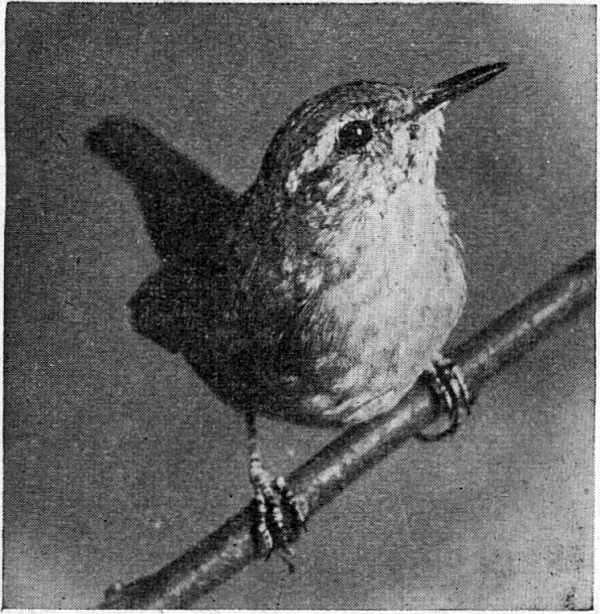
HERE IS STUMPY—THE WREN—A LITTLE BIRD WITH A VERY BIG VOICE
He is a little brown bird, smaller than a sparrow, with rounded wings and a sharp beak, and he is barred all over with dusky stripes, as you will find if you see him at close quarters.
He does not come out into the open and attract our attention as the robin does, nor does he bother much about the bird-table. He likes to hunt in all the nooks and crannies forgotten by the other birds. He creeps behind the ivy leaves, he squeezes into the thatch, he searches every corner of the wood pile, and as his hunting takes him so often into these hidden places we do not see him as much as we might. You may think he is a mouse sometimes, when you see him creeping rapidly from place to place!
Although he is very small, he has a most enormous voice. To hear him sing you might think he was as big as a rook! His song is very clear and ringing, and almost sounds as if it were a challenge to other birds, it is so bold and defiant. He always ends it with a few very loud ringing notes. You cannot mistake his song once you have heard it, and I am sure you will be astonished to see what a small bird it is that is singing such a torrent of loud notes. When he is angry or frightened he makes a queer grating sound, as if he were winding up a big clock.
The wren loves to make nests. One little wren here at my home is always making them, just for fun. I cannot think of any other reason! Do you know where it makes them? In the thatched roof of my cottage! I really couldn’t tell you how many wrens’ nests there are there—some just little holes, some with a bit of lining made of moss, and one or two quite finished. The last nests have been used for eggs, and were made properly and lined beautifully. The wren visits all his other funny little nests occasionally. I see him popping in and out of them, as busy as can be. In winter he roosts in one, cosy and warm. His real nest, the one used for eggs, is made of something near by—leaves, moss or dry grass, for instance. He tucks these into the hole he has chosen in the thatch (or in a stack, tree-trunk, wall or bush) and lines the nest softly with hair or feathers. His tiny wife lays a big cluster of eggs there—sometimes as many as eight or more—and then sits patiently until they hatch.
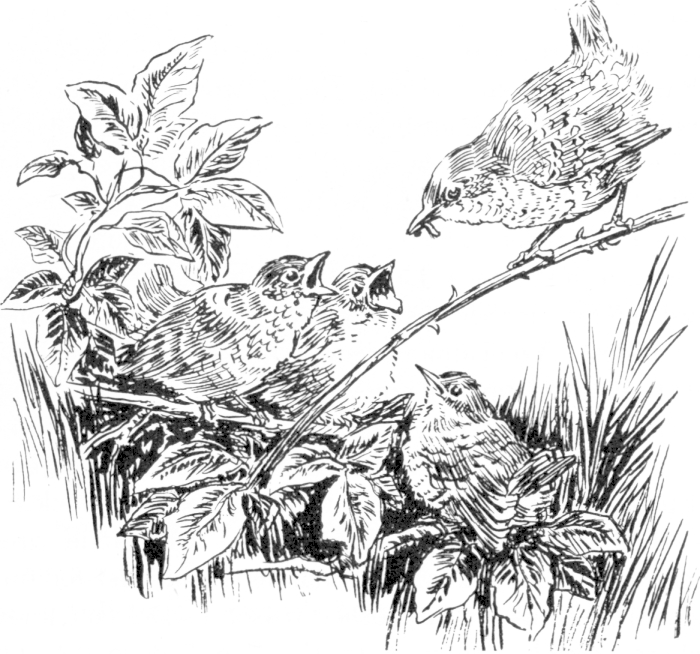
A WREN FEEDING HER BABIES
The wren does not mind his nest being easily seen. Last year my little wren built in the thatch directly over the garden door, on the sill of which my two cats sat every day. When the eggs hatched, and the tiny nestlings could see, they would peep out of the nest each time anyone came in and out of the door, but they were not a bit afraid. They flew off safely, and are still about the garden, grown-up now, as busy as their parents, and as loud-voiced. Sometimes two or three sing at once, and I can hardly hear myself speak!
The eggs are white or may be slightly speckled.
The wren eats a lot for his size. He likes spiders, small insects, chrysalids, and in the winter-time he will eat seeds. He is not so ready to eat crumbs, potatoes, and the other things we put on the bird-table—which is why we seldom notice him there.
I hope you will see him soon, if you have not already made friends with him. If you hear a loud song in the garden, with a trill in it rather like a canary’s, rush out to see if you can spy the singer—it is sure to be a wren!
THINGS TO DO
Write down two things about a wren.
Write down two things about a robin.
Look closely at a robin next time you see one. Remember his colours, and draw one and colour him.
Draw an old saucepan. Put a nest inside with four eggs. Draw the robin standing near.
Try to tame the robin in your garden.
Everybody has seen foot-writing in the snow—the prints made by feet as they walk, jump or run. Perhaps you, if you live in a town, have not seen many prints. You have seen human tracks, the prints of horses’ hoofs, and those of cats and dogs. Those who, like me, live in the country, can see many more. There are fox tracks, rabbit and hare prints, the foot-marks of pheasant, partridge, moorhen, coot, thrush, blackbird and many other birds. There are rat-tracks, weasel and stoat prints, and even, if we are very lucky, the big marks of the broad-footed badger.
We will let all the different creatures describe their own foot-writing, and tell us why their prints differ so much from one another in shape and position. The dog shall have the honour of speaking first.
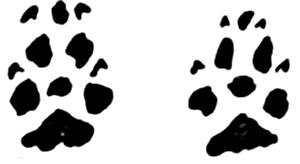
I walk on my toes, so, if you look in the snow (or in the mud, either, for that matter!) you will see only the imprint of my four sets of toes. You know, don’t you, that I cannot draw in my claws as the cat does, so you will find that I have left a print of my claws as well. My track is not very neat. Sometimes I leave big prints and sometimes small. It depends what sort of a dog I am! You will find that if I walk on hard, crisp snow my prints are smaller than on yielding snow, because then I have to spread out my toes well to keep a firm hold. Please give your dog a run in the snow, and find out just what tracks he leaves.

I am a neat walker, and as I must hunt my prey in silence, I am very careful where I put my feet. I like to put my hind feet in the same place as I put my fore-feet, so if you look at my snow-writing you will usually see that my tracks are in a single line. If I run, you will see my tracks in pairs, because I go bounding along then, front feet close together, and hind feet close together.
You will not see my claws in my prints because I take too much care of them to allow them to rub against the ground, as the dog does. I draw them closely into their sheaths, and so keep them sharp-edged.

I cannot very well show you my real foot-print, because I have to wear iron shoes, so you will only see the tracks of those in the snow. If you could see my prints without my shoes, you would see that my hoof is all one—not split in two like the cow’s.

I am as neat a walker as the cat, because I too hunt silently and stealthily, and, like all animals who hunt quietly, I place my hind feet in the same spot as my fore-feet. It is sometimes difficult to tell the difference between my writing and the cat’s—but if you look at my track carefully you will see the marks of my claws. I belong to the dog family, you see, so I cannot draw in my claws, but, like the dog, allow them to scrape the ground. There is another way in which I show that my track is mine. I have a fine tail, bushy and thick, and sometimes, when I stop to sniff the air, I let it brush the ground. It leaves its trace, and, when you see it, you can say—“Ah, a fox passed here!”

On the snowy hillside or over the white meadows you will see dozens and dozens of my foot-marks. I do not sleep in the winter, you know, and even on the coldest morning I come out to look for food. It may be that I can find nothing except perhaps a bit of ivy-bark to gnaw. You will see my foot-prints all mixed up with those of my brothers and sisters. When you find a single track you will be sure to make a mistake about the way I am going, for I leave rather a puzzling trail.
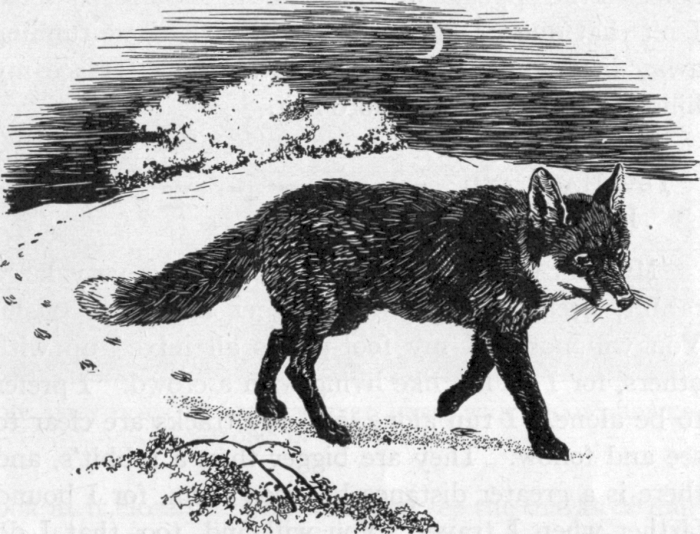
YOU CAN TELL THE DIFFERENCE BETWEEN THE TRACKS OF A FOX AND A CAT, BY THE MARKS OF THE FOX’S CLAWS
My little front feet are placed close together when I run, and my big, strong hind feet you will see printed long and deeply in the snow—but, when I travel, I always place my hind feet right in front of my fore feet! and therefore, when you see my track, you think I am going in the opposite direction to the one I really took. Isn’t that queer? Look at the picture of me running away in fright. Then you will see how I place my hind feet in front of my fore feet.

My foot-print is rather like that of a very large rabbit, because I am much bigger than my cousin. You will not find my foot-prints all mixed up with others, for I do not like living with a crowd. I prefer to be alone. I run alone, and my tracks are clear to see and follow. They are bigger than a rabbit’s, and there is a greater distance between them, for I bound farther when I travel. You will find, too, that I do not turn my feet out quite so much as my cousin does.

I leave the neatest track of any animal. It is rather like a chain of small round holes in the snow, and you may well wonder how I leave them. I will tell you. Like the cat and the fox, I hunt quietly by stealth, and I put my hind feet in exactly the same spot as that in which I placed my two little fore feet. Scrape the snow gently away from one of the little holes and look at it closely. You will then see the marks of four tiny feet, all bunched together! When I walk you will see the prints opening out a little, but walking, running, or leaping, my foot-writing is always very neat, and deserves, I think, full marks!
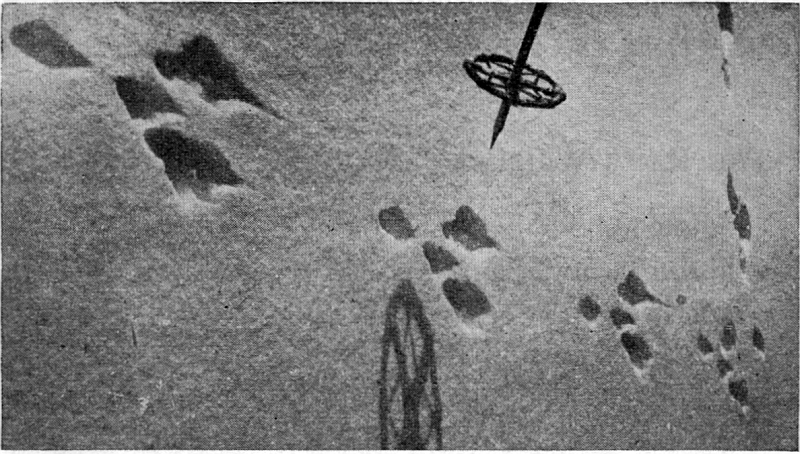
THE SNOW-TRACK OF A FRIGHTENED HARE, WHICH HAD HURRIED ALONG IN RUSHING LEAPS
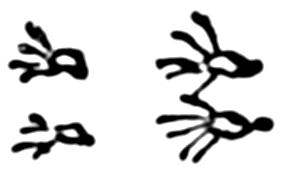
I like to sleep most of the winter—but I wake up sometimes to have a feast. Then you may see the marks of my long-toed feet quite clearly in the snow. You know, I expect, that I have small front feet, in which I like to hold my food, and big hind feet to help me to bound along. I do not put my hind feet in front of my fore feet, as the rabbit does, but a little way behind them.
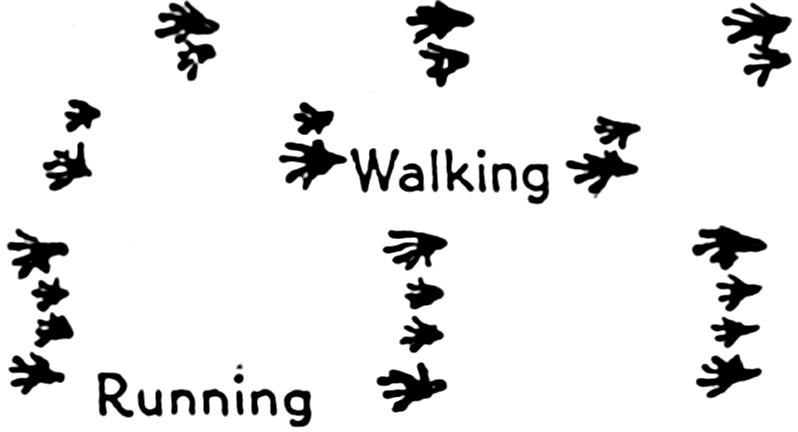
I know nobody likes me, but I don’t care, for I am fierce and savage. I leave a track rather like four little hands. There are four fingers on the front paws, and five on the back ones. Sometimes I leave the print of my long tail, too. If you find a track of me walking you will see that the prints are in pairs—a little front foot beside a big hind foot all the time. But if I run you will find all four feet in a straight line, with the little fore feet inside the big hind feet.

You will know my track when you see it, for I leave big prints, with the claws clearly marked at the tip. My fore feet always point straight forward, but my hind feet turn in badly. I am afraid I walk in a shambling way, like a bear. If you are ever lucky enough to see my foot-prints, you will find that my hind-prints spoil my front ones by over-lapping them. Please find a picture of me. I am really rather a nice creature.
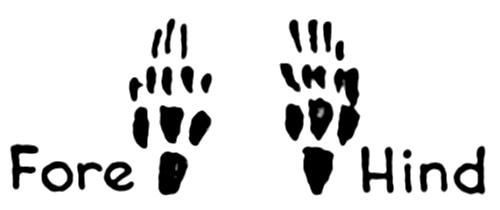
It is a bother to wake up in the winter, so I usually try not to—but if I do I write in the snow like any other animal. I have such short legs, though, that generally my body brushes against the ground as I walk, and destroys the foot-prints I make. My feet are long in shape, and in my foot-prints you may see the marks of my claws at the tip.

We can all speak at the same time, for we all show hooves split in two. We call them cloven hooves.

You will not be able to tell which print is made by my right foot and which by my left, when you look at my snow-tracks, for I place each foot exactly in front of the other. I swim on water, and run on land, so, in order to run quickly, I have long, strong toes, not webbed. Have you seen me swimming? I bob my head in a sort of clockwork manner, and this is because I have to push so hard with my unwebbed feet when I swim that my head is jerked forward with my efforts! I put my feet one in front of the other when I walk, because as my path lies often through weeds and mud, it is easier to walk like that than putting them first to one side and then to the other.

Like my cousin, the moorhen, I can swim and dive—but unlike him I do not like running about on land. I have grown lobes on each of my toes, and these help me in my swimming. If the ponds get frozen over I have to leave them and go to the rivers, where there is running water. But sometimes I am taken by surprise, and find my pond so suddenly frozen that I am driven to the banks—and then you will find the fiddle-shaped marks of my curious toes! Can you find a picture of me and the moorhen?

We tree-birds, such as the chaffinch and the sparrow, always hop, so you will find our foot-prints in pairs. You see, we are so used to jumping from one twig to another that when we are on the ground we still jump, or hop, with our feet close together! Look for our marks round your bird-table.

You know us well, for you have seen us often. We are birds like the pigeons and the starlings, and we do not hop. We are really more at home on the ground than in the trees, so we walk. You will find our foot-writing quite easily, one print alternating with another, with sometimes a pair close together to show you where we stood still.
Now that the animals and birds have told you all about their foot-writing, go and see it for yourself as soon as the snow covers the ground. Take a walk and see how many of the different writings you can read.
THINGS TO DO
Let your dog or your cat out in the snow and see their foot-prints. Draw them.
Go out into the snow yourself. Walk. Run. Jump. Notice how different your three tracks are.
Write down the reason why a cat does not show her claws in her snow-tracks, and why a dog does.
Pretend you are a sparrow. Explain your foot-prints and draw them.
Take a note-book and go to the bird-table, if your school has one. Draw in your book some of the snowy-tracks you see around it. If you have no bird-table, walk out in the snow, and then draw your own tracks.
All through the autumn we saw the trees changing colour as their leaves glowed yellow, orange, purple, red or pink. Then, one frosty morning, down the leaves fell in hundreds and the trees began to look bare. More frost and a big wind took the rest of the leaves away, and now, when we look out of the window, we see strong, bare branches and a multitude of little twigs laced against the sky—but no leaves. Only the dark evergreen trees, whose leaves never change colour, stand dressed in foliage. All the other trees are bare.
Do you know why the trees drop their leaves and strip their twigs so bare? There is a most interesting reason for this. Perhaps you didn’t know it, but leaves have a great many little holes over their surface, called stomata, and through these holes the water in the leaf evaporates very quickly. This is a good idea in the summer, when the roots can take up the water in the soil and send it in plenty up to the leaves—but in the winter, when the ground is frozen and the roots cannot take up water, the leaves would be very wasteful of moisture, just when the tree needed to be careful.
“Very well!” we can imagine the tree saying, “I will get rid of my leaves in the winter-time! Then they cannot evaporate away what little water I have! I will grow new leaves when the warm weather comes.”
And that is just what the tree does! It throws off all its water-wasting leaves, prepares new ones tightly wrapped up in buds, and waits for the spring. Whilst it is waiting it is resting. It does no work, but treats the winter as a long night and sleeps soundly.
You may wonder how it is that the evergreen trees do not drop their leaves in the autumn, too. Take an evergreen leaf in your hand and feel it. Isn’t it hard and tough! A holly leaf, with its waxy toughness, is quite difficult to tear. As for the pines, why they have leaves more like needles than leaves! They have done away with the large leaf surface, and, so that they cannot lose much water, have made their leaves as small and thin as possible. Only by tough, thick leaves, or needle-like leaves, can trees prevent a great loss of water in the winter-time.
But the leaves of other trees are thin and delicate, and, having a large surface, they lose a great deal of water. So off they go in the autumn, leaving behind them the buds of new ones.
How does the tree arrange to send them away? You would never guess! I expect you know that the tree has thousands of little sap-tubes or water-pipes, through which it sends moisture up to the leaves.
Now when the autumn comes and the leaves are to fall, the tree carefully stops up all the water-pipes leading into the leaf-stalk! It grows a layer of cork over them, and after a time no water can pass into the leaves. You know what happens to leaves if you put them into a vase with no water, don’t you? They dry up and die.
That is what happens to the leaves on the tree. They begin to dry up, and, as the cork layer separates them from the twig, they are ready to snap off at a touch. Down they go, leaving a scar on the twig to show where once they grew. The scar not only shows the size of the leaf-stalk and the shape of its base, but also the little stopped-up ends of the water-pipes.
Take a horse-chestnut twig and look at it. Do you see the horseshoe-shaped scars there? That is where the leaves fell off this autumn. They were big leaves on big stalks, so they left big scars—and those little dots that look like the nails in the horseshoe are the stopped-up water-pipes! Each nail is a little bundle of pipes. If we could see the leaves that fell off, and could look at the bottom of the leaf-stalk, we should see the same pattern of nails there, too! They show where the water-pipes entered the leaf.
How do the leaves get their lovely colours before they fall to the ground? They get them in a curious way. The tree uses its leaves in autumn as a sort of dustbin and sends to them a great deal of waste-matter that it wants to get rid of. It is this rubbish that paints the leaves so brilliantly! But although it is waste-matter to the tree, it is of value to the soil, and gardeners keep the dead leaves to make leaf-mould, which is of great use in the garden.
Have you some beech-twigs there? Pass one or two round and look closely at the places on the twigs where you can see funny little circular rings, rather like those you see on the top of a screw-on jar. You may see two or three on each twig. They are not leaf-scars, because they go all round the stem. They are bud-scars, and I will tell you the way in which they are made.
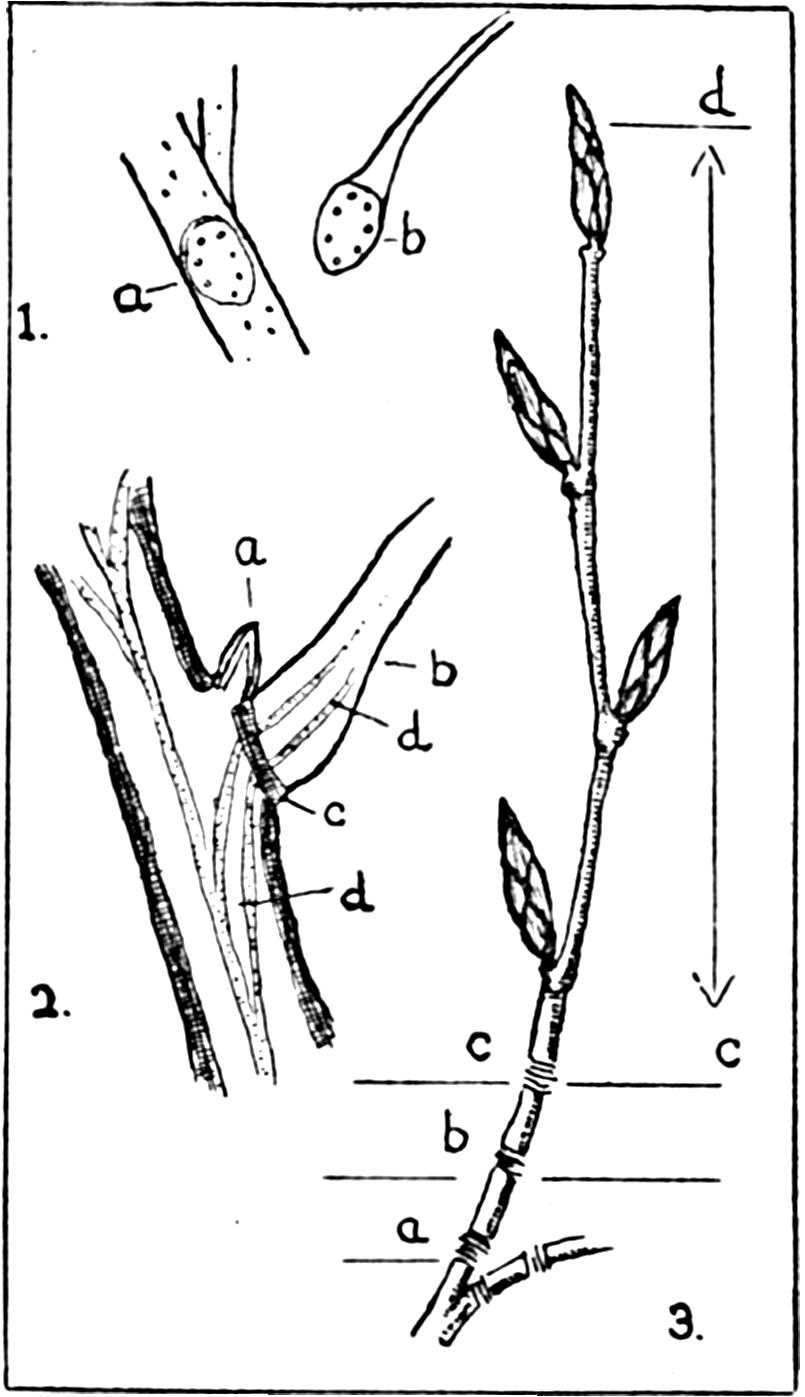
THE STORY OF THE TWIG
1. Leaf breaking off twig: (a) Scar left on twig; (b) Duplicate scar on base of leaf-stalk.
2. Leaf becoming separated from twig: (a) Next year’s bud; (b) Leaf-stalk; (c) Layer of cork between twig and leaf-stalk; (d) Water-pipes.
3. Twig of beech showing three years’ growth by the bud-scars; (a-b) 1st year; (b-c) 2nd year; (c-d) 3rd year.
Look at the top bud of your beech-twig. Do you see how well it is wrapped up in many scales of brown? When the warm days come those scale-leaves will loosen and open. One by one they will fall off all round the bud—and as they fall they will leave a scar to mark where they grew. When they have all fallen off we shall see a number of little rings all round the twig—the bud-scar, marking where the bud-scales grew.
Look at the different twigs you have, and find the leaf-scars and bud-scars there. Some twigs, like those of the horse-chestnut, have very big leaf-scars. Some, like the beech, have small ones because their leaves are small. The bud-scars always circle the stem.
Do you know how a bud grows into a twig? Perhaps you didn’t guess that each bud on a tree grows into a new twig, but thought that only a leaf came out! No, from each bud (except in the case of some flower-buds) a twig grows during the year, complete with leaves and new buds for the next year. I will tell you how it happens.
Look at a bud on a beech twig. When the warm days come the brown scales unfold and fall off, and the tiny green leaves inside shake out their folds and spread themselves. They are all on a very short stalk. As the leaves grow bigger the stalk grows longer and the distance between the leaves lengthens. New leaves grow at the top of the twig, and as the summer goes on the stalk gets longer and longer, until when autumn comes it may be six or eight inches long! It is a little twig in itself—and it all came from that one tiny bud.
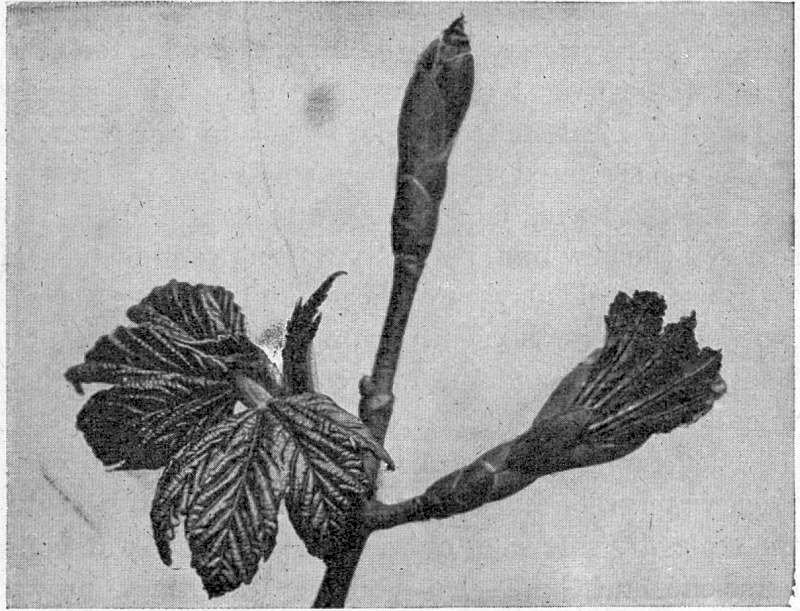
A SYCAMORE TWIG WITH ITS BUDS SLOWLY OPENING. GET SOME AND WATCH THEM IN YOUR SCHOOLROOM
Now if each bud does this you can quite well see how trees grow broader and taller each year. And, as each spring the bud-scales leave the bud-scars we spoke of, you can easily see the growth made from one year to another by looking at the space between the bud-scars. Look at a twig now and measure the space.
In the summer-time when all the trees are green with leaves, you may find the little new buds for next year on the twigs! You will see them lying snugly between the leaf-stalk and the twig, and this is about the most sheltered place they could have. In the autumn the leaves fall, leaving a scar, and above the scar sits the new bud, patiently waiting to grow bigger.
But the cold days are ahead, and the tree sleeps. No work is done, no growth is made. The bud waits. The frost comes and the rain comes. How is it that they do not kill the tender young bud?
They cannot harm it because it is covered up with thick waterproof scales, and is often protected beneath the scales by soft wool or warm down. Look at your horse-chestnut bud. Do you see the thick brown scales covering the bud? Touch them. Are they sticky? The gum prevents the rain from harming the leaves hidden beneath. Pull off the scales. What soft woolly coverings there are underneath, keeping the young leaves warm and safe!
Someone else finds the sticky gum outside the buds useful besides the young leaves. The bee hunts for it in the early spring to use for stopping up any holes or cracks in its hive. There is always a faint humming among the horse-chestnuts as soon as the weather gets warm and the bees are out seeking gum. Listen for it this coming spring.
If you take off the outer coats of the bud you will find the minute green leaves tucked away inside. They are folded very carefully in all kinds of different ways. The beech pleats its leaves like a fan. The horse-chestnut folds its leaflets into two, like sheets of note-paper. The pear rolls its leaves up very neatly from the outer edge to the mid-rib. All the trees have good ideas to save space in the bud.
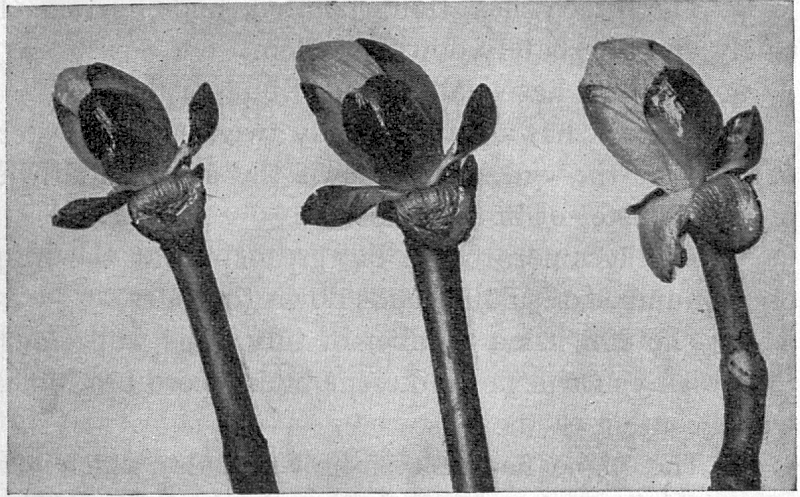
HAVE YOU ANY HORSE-CHESTNUT BUDS LIKE THESE? THEY ARE JUST BEGINNING TO OPEN
You should be able to recognise a few trees in winter, even though there are no leaves to guide you.
1. The horse-chestnut you know well, because of its big fat buds with their sticky coats.
2. The ash has stout black buds, very solid-looking, arranged in pairs.
3. The beech has thin, pointed buds, arranged singly and alternately down the stem.
4. The lime has small, rounded buds, ruby-red.
5. The oak has a rather untidy twig, with a cluster of buds at the end, a few down the stem and then another cluster of brown buds.
6. The sycamore has a big green bud at the top, and a number of smaller buds down the sides.
7. The elm has a number of tiny buds, and along the twigs you will find different buds, more bead-like, which contain the flowers.
8. The plane has reddish-brown buds, which are protected in a clever way before the leaf falls. The base of the leaf-stalk fits exactly over the bud, and inside the stalk the bud remains safe and sound all the summer until the leaf falls off and reveals its secret. By that time the bud is big enough to look after itself.
THINGS TO DO
Find as many twigs as you can. Find out their names and put them in little jars on the Nature table to watch them come out. Put their names on the jars.
Draw a horse-chestnut twig. Draw a beech twig.
Write down how it was that your horse-chestnut twig came to have its horseshoe-shaped scars.
Write down the way in which a twig grows from a bud.
Find some twigs to keep at home in a jar. Change the water each week. Take them to school to show the others as soon as they begin to open.
If you have any clay, model one of your twigs in it.
There are a great many different kinds of tits, but I am only going to tell you about the three you are likely to know well—those that come to our gardens or to our windows. What are their names? Some of you will know them, I am sure! The Great-Tit or Ox-eye is one, the Blue-Tit or Tom-Tit is another, and the third is the little Coal-Tit, the smallest of all and the least common.
The proper name for the tit family is Tit-Mice! It seems a queer name, doesn’t it—but a very good one if you think of the habit the tits have of running up the tree-trunks and along the branches like tiny mice!
The tits are the acrobats of birdland. They don’t mind whether they are hanging the right way up or head downwards; they are so agile they can perch on the tiniest foothold, and they swing themselves about in all sorts of positions as they feed. No other bird is quite so acrobatic. If the birds ever held a circus of their own the tits would certainly get the most applause!
All three tits are fearless and friendly. They will swing on a coconut just outside our window, and let us watch them at any time. They will live in our gardens all the winter if only we will provide for them the food they like. They will not feed from our hand as the robin will, but they are quite ready to fly down to a bone we have hung up, almost before our hand has left the bone!
They are pretty, dainty birds, delightful to watch and to know. I will tell you the difference between the three of them, so that you can watch for each and recognise them when they come.
As his name tells you, the Great Tit is the biggest of the three, about the size of a sparrow. He is a smart, glossy bird, dressed in yellow, black and green. His head is a shining blue-back, very dark, and down his breast runs a deep black stripe, by which you may always know him. He has a strong beak and bold, bright eyes.
I am sure you have heard his loud call, especially in the springtime. It is two notes, see-sawed up and down, and they sound like “Pee-ter, Pee-ter, Pee-ter, Pee-ter, Pee!” It is a rasping sound, and has earned him the queer name of Saw-sharpener! Play the sound on the piano—high G, E, high G, E—a few times, and sing “Pee-ter” as you do it. Then you will soon know what sort of call he makes.
He also says, “Pink! Pink!” very loudly, rather like the chaffinch. He has a trilling song, too, that sounds like “tzoo-tzoo-werry, tzoo-tzoo-werry, tzee-tzee!” You will have to listen to him carefully whenever you can, and you will soon get to know his imperious little voice.
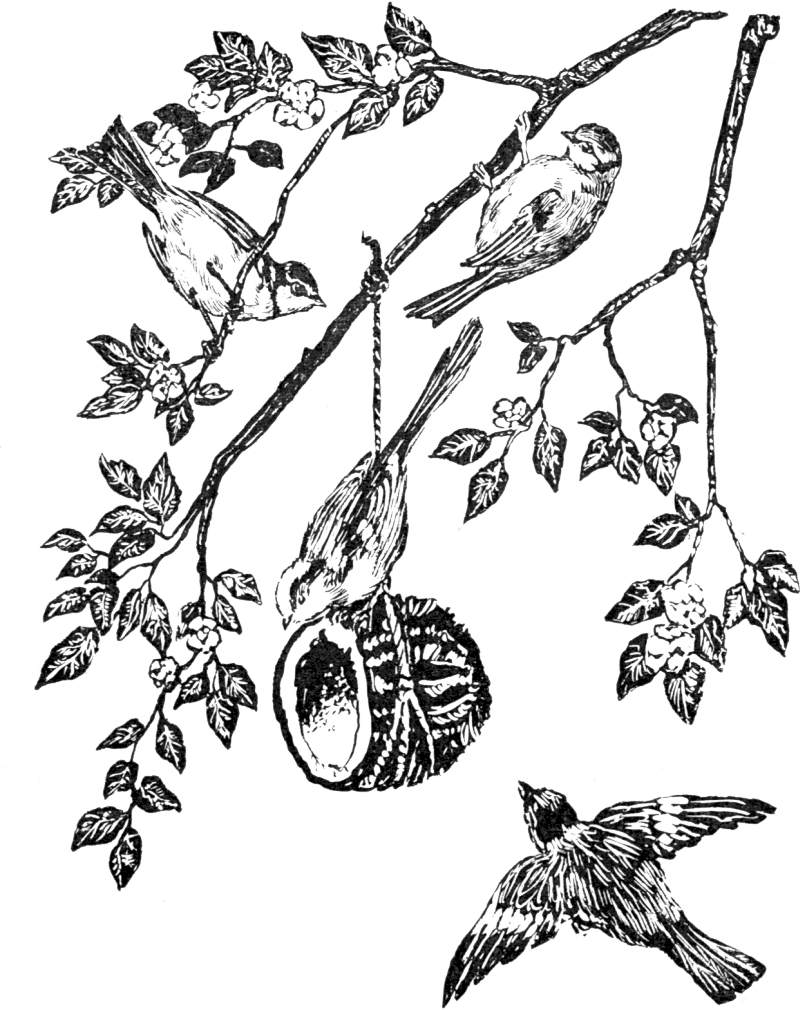
TITS AT PLAY
The Blue-Tit is my favourite of the three. He is such a fearless, excitable, gallant little bird, full of life and as sharp as a needle. You may know him by his blue cap encircled with white, and his green, blue and yellow dress, and small size. Look for his blue cap, from which he gets his name, and you will be able to recognise him at once. His beak is not so strong-looking as the Great-Tit’s, but he does very hard work with it, all the same, pecking great pieces of coconut out, and chipping away at monkey-nuts and bones!
He is a most excitable, pugnacious little creature. When he finds a new coconut hung up, or sees that I have put a fresh supply of nuts in the pea-nut feeder, he calls loudly to all his friends to tell them the great news—and then, when they come to feast too, he scolds them vigorously, raising up the blue cap on his head until it looks like a crest, and flies angrily at the newcomers!
He can’t keep the news to himself, but he wants to keep the food for himself, the funny little creature. Many times a day I look out of my window and hear an excited churring of tits, and see two fall to the ground, pecking one another in a great rage. Not much harm is done, but oh, what an excitement it makes in the little world of tits!
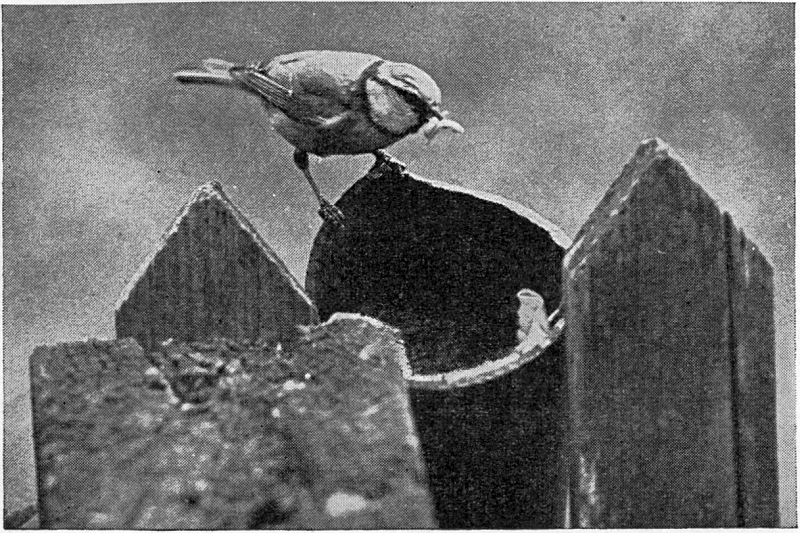
[Eric Hosking.
THIS BLUE-TIT HAS CHOSEN A BROKEN DRAIN-PIPE FOR HER NEST
The Blue-Tit is perhaps the best acrobat of the three. If I hang up a monkey-nut on a long thread, the Blue-Tit will fly straight to the little nut, catch hold of it and swing upside down on it, pecking away all the time, swaying to and fro on the long thread. The Great-Tit will do something quite different. He will fly to the table from which the nut hangs, and haul up the thread “hand over hand” until he has pulled the nut up. Then he will peck it and eat it! Hang up a nut and watch for yourselves.
One of the commonest noises in the springtime round about my cottage is the call of the Blue-Tits. “Pim-im-im-im-im! Pim-im-im-im-im!” they cry to one another, the Pim two notes higher than the rest. Sing it yourself, and you will hear what it sounds like. Keep your teeth closed whilst you make the sounds. When the tits begin to call in the springtime you must listen hard for them. It is such a lovely feeling when you hear a bird calling, and can say, without seeing it, “Oh, that’s a Blue-Tit!” or “That’s a Wren!”
The Coal-Tit is the smallest of the three common tits. He has a coal-black head, and down the nape of his neck you will see a white streak. By this you may know him, so look out for that. His colouring is not so bright as the others. He is more greyish, duller altogether. He looks as if he wanted a “wash and brush-up.” But he is a dear little bird, just as acrobatic as the others, and almost as fearless.
His call is very much like the Great-Tit’s, but the other way round. The Great-Tit puts the accent on the high note—Pee-ter, Pee-ter—and the Coal-Tit puts it on the low note, his call sounding rather like “If-fee, if-fee, if-fee, if-fee, if-fee!” Have you heard it?
Most tits love to nest in holes of some sort, and they will often choose the queerest, most unexpected places, such as a letter-box. Holes in trees, in walls, and in stumps, or old nests of other birds or of squirrels will do for them. They fill the hole with soft material such as moss, leaves, or grass, and line the nest with hair, feathers, rabbit fur, and cobwebs.
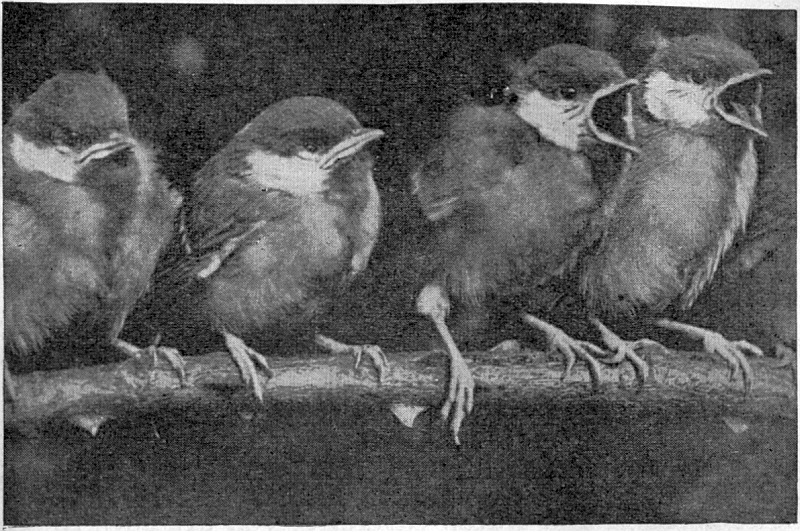
“PLEASE MAY WE HAVE SOME DINNER?” A HUNGRY FAMILY OF GREAT-TIT NESTLINGS
They lay a large number of eggs, often more than a dozen; the eggs are all much alike save that the Great-Tit’s are bigger. They are white with red spots. The birds sit closely on their eggs, and if anyone puts his hand into the hole where the nest is built, the tits hiss like snakes, and peck viciously at the intruder’s hand.
Tits often roost at night in ivy and evergreens, but if you like to put out old coconut shells, flower-pots hung against the wall, or a box with a hole in it you will perhaps find that they are occupied by tits during a cold night!
All three tits do a great deal of good, for they eat millions of grubs and caterpillars each year. They sometimes damage the fruit-buds by searching for grubs inside, but the good they do far outweighs the harm. It is said that in one day a couple of tits feeding their young ones may take as many as one or two thousand grubs to them.
Try to rear a family of tits in your own garden or school garden. If you put out a nesting-box in the right position and watch carefully, you are sure to see the tits peeping into it, trying to make up their minds to live there! And what fun it is when they build inside your box and you have the joy of seeing a large family of fluffy yellow tit-babies rushing about all over your garden.
THINGS TO DO
Hang up a string of monkey-nuts in your garden.
Write this down—“The Great Tit has a black head and a black streak down his breast. The Blue-Tit has a blue cap, and is smaller. The Coal-Tit has a coal-black head and a white streak on the nape of his neck. He is the smallest.”
Listen for the tits’ calls, learn them and whistle them back to the tits whenever you hear them calling.
Draw a coconut hanging up and tits flying round.
Printed in Great Britain by Richard Clay and Company, Ltd.,
Bungay, Suffolk.
THE END
Mis-spelled words and printer errors have been fixed.
Inconsistency in hyphenation has been retained.
Some faded photographs have been enhanced.
[The end of Round the Year with Enid Blyton—Winter Book by Enid Blyton]